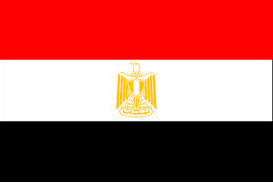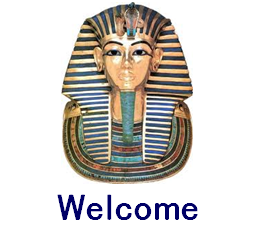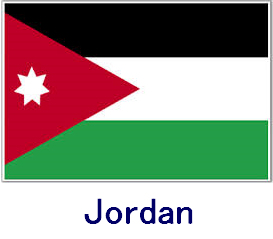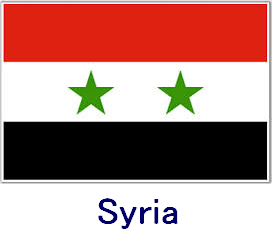One Huge Cemetery
Ancient Egypt and its monuments to the dead and the afterlife are why a dysfunctional country on a dysfunctonal continent in a dysfunctional region is so well known and, until at least recently so widely visited. Modern Cairo has a massive necropolis at its centre that is a drawcard for the morbidly curious and it is home for millions - dead and alive together. Egypt's icons, the pyramids, are giant tombs and a mummy, a corpse, could not be mistaken as a symbol of any other country.
Everywhere along the Nile are reminders of just how old and how extensive and advanced and obsessed with death the ancient Egyptians were. Modern Egypt, as represented by Cairo and Giza is crowded, dusty, dirty, shambolic and ramshackle. There's a sense of desperation to the place - people living hand-to-mouth with hopes for a better future without many signs of a faith in a better after-life like that of the ancient Egyptians. Compliance to the strictures of an all-pervasive religion doesn't do much to keep the family fed - the widespread distaste for the short-lived Islamic Brotherhood government showed many Egyptians can separate dogma from the prospects of a meaningful future in this life.
Luxor-Karnak and Aswan are a lot less confronting than is Cairo - these places are less in-your-face, a lot tidier and most noticeable of all, in comparison to Cairo they're quiet. But, Egyptians whose livelihood is derived from tourism were doing it tough in the downturn of the GFC and would've been doing it even tougher in the turmoil of post-Mubarak politics. Luxor and Karnak were not immune to the struggles of the average Egyptian, and it showed in the interactions with many of the locals - polite, but tinged with desperation.
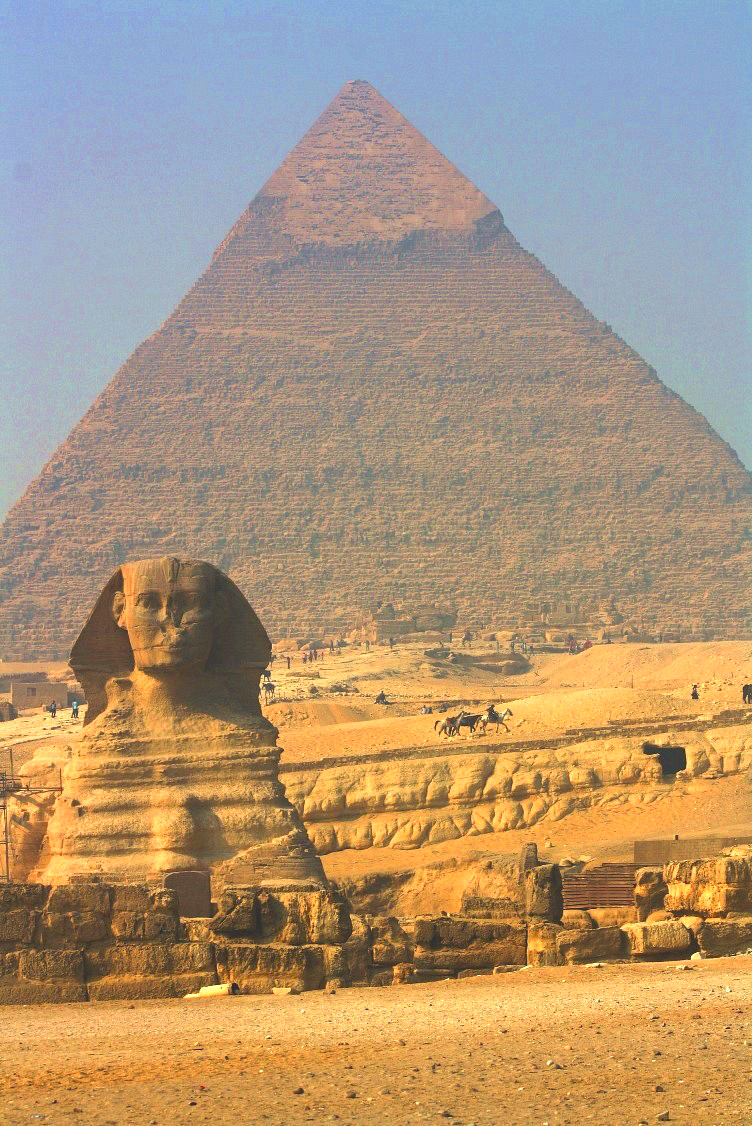
Cairo
Bucket List Rating 




The largest city in the Arab world and Africa with a population of 6.76 million and spread over 453 square kilometres, 15000 people per sq km. What doesn't look falling down looks half finished. Dusty, grimy, frantic and noisy. But that's part of the attraction and there are fascinating and rewarding aspects:
Egyptian Museum. A treasure trove of Egyptian antiquities including King Tutankhamun's gold mask and Rameses II's dried up corpse. Located on Tahrir Square, the epicentre of the riots that ended up in that crooked old bastard Hosni Mubarak being thrown out of office in February 2011...the month after the Geezers left for home. Coincidence? Perhaps.
Khan al-Khalili bazaar and the Cafe el-Fishawy. Khan al-Khalili is the heart of Islamic Cairo and el-Fishawy is the heart of the Khan, located deep in the maze of narrow passageways. Khan al-Khalili may cater for tourists with expensive gold and silver jewellery through to fake antiquities and tat but the locals shop here too so there's a real feeling of authenticity, particularly farther afield. An on-foot search for the Street Of The Tentmakers took us down narrow, crowded streets lined with artisans shops, dodging the occassional camel plop and the silent, electric scooters that possibly caused many of the camels to plop in the first place.
Coptic Cairo. A part of Old Cairo which encompasses the Babylon Fortress, the Coptic Museum, the Hanging Church and the Greek Church of St. George.
The City of the Dead where families, up to half a million people, live within the million or so tombs. Some have been there for generations. Others are more recent tolerated squatters displaced from the Suez Canal zone during the 1967 war or by dislocation due to urbanisation pressures.
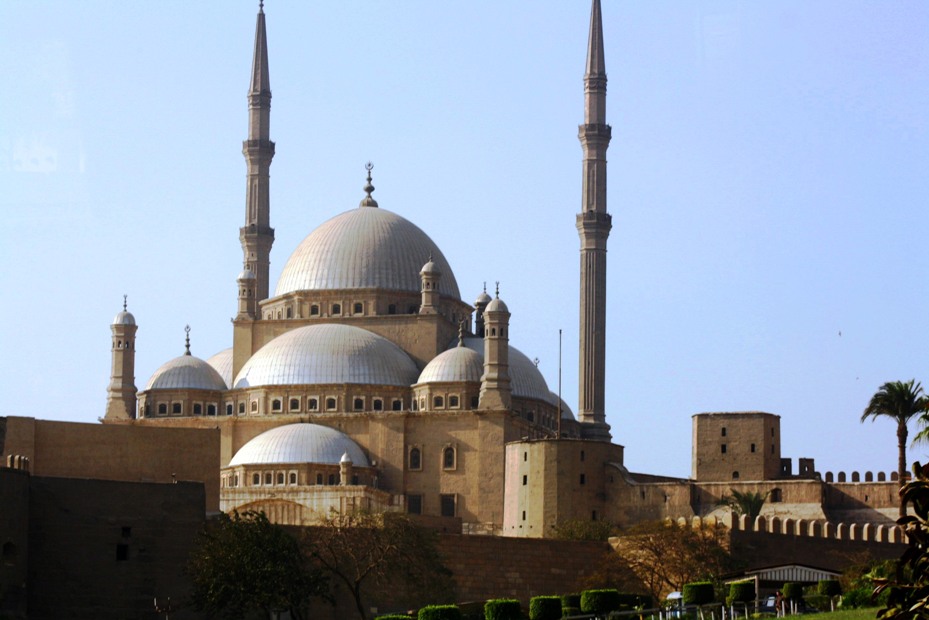
Muhammad Ali Pasha, the father of modern Egypt, erected this Ottoman-style mosque (1828 - 1848) as a monument to himself or to his second son depending on your sources. It's a part of the Citadel - the medieval centre of Cairo and site of Muhummad Ali Pasha's massacre of 700-800 Mamluks, the then feudal owners of Egypt. .
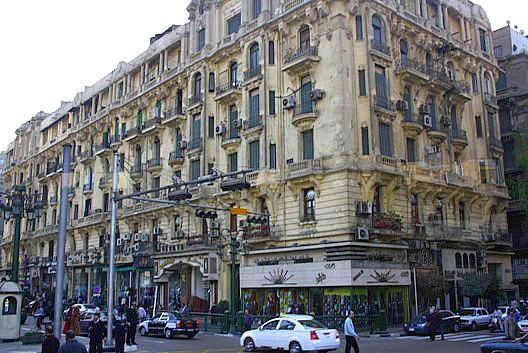
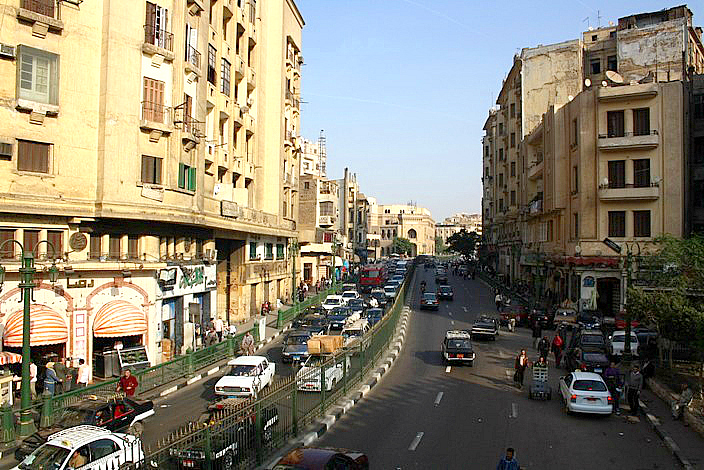
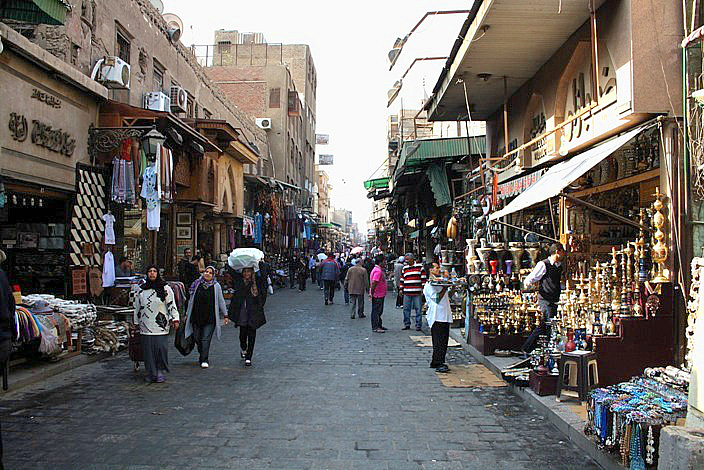
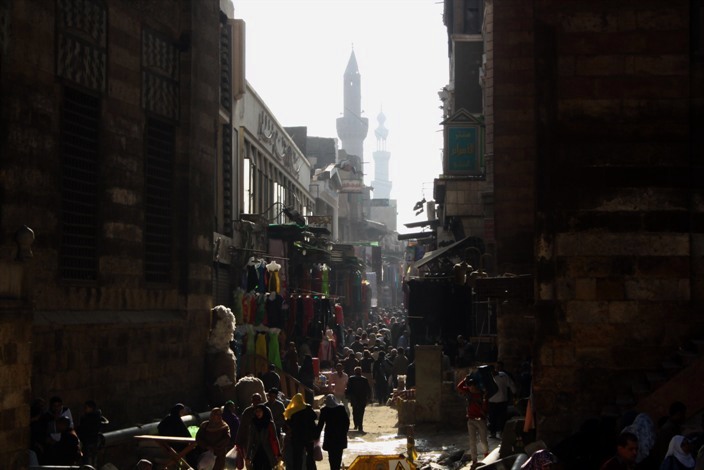
Khan al-Khalili souq dating back to 1382 and its surrounds. A labarynth of open alleyways and enclosed passages lined with shops and stalls selling jewellery, fabrics and spices, and all keen to get your business. Two amusing spiels used to try and sell me something: "You cannot smoke here in the street. You must come into my shop to smoke" and the more straight forward "How can I get your money?". The improvisation of one stall holder at Abu Simbel, responding in a falsetto voice to Lyn's shouts to locate Sean with "I'm in here mummy" got a laugh from the other stallholders.
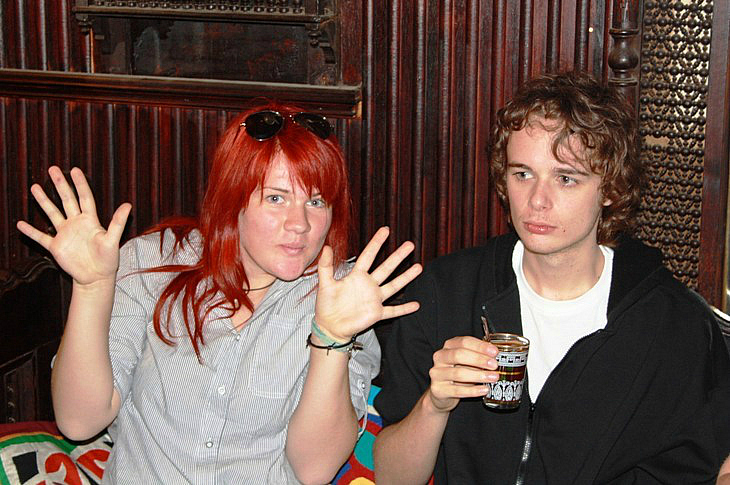
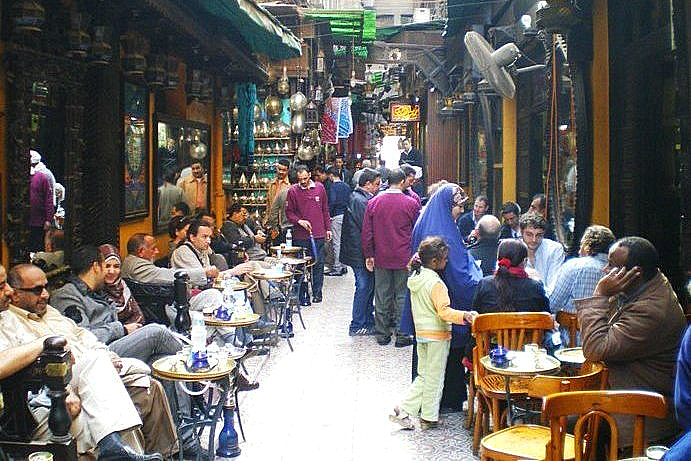
Hot tea at the Café el-Fishawy. 240 years ago a man named el-Fishawy began serving coffee to his friends in an alley of the Khan al-Khalili district each evening after prayers. Fishawy's Café is now the most renowned café in the Arab world with the traditional Egyptian social style of relaxing over coffee, tea and tobacco. Ushered into a back room behind shuttered doorways in a small wood panelled room festooned with dusty old mirrors, filled with shisha smoke and not another tourist in sight it was easy for us to feel 'immersed in the local ambiance'. Olivia's uncovered bright red hair and shirt sleeved attire generated muttered and obviously ribald comments from many of the younger lurkees in the souq.
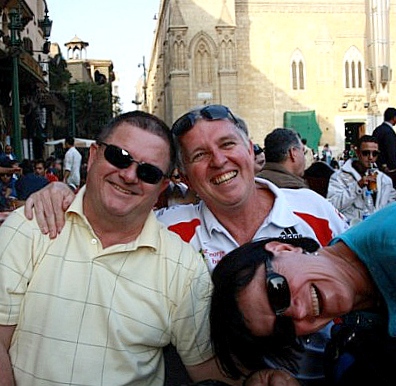
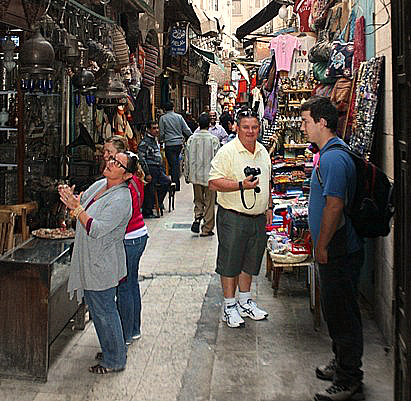
Bruce, Chris and Rita at a cafe on the perimeter of the souq. The El-Hussein Mosque is in the background, housing a mausoleum that dates to 1154. A pleasant observation point to watch the hustle and bustle while indulging in Egyptian teas, gelatos and a shisha. Such relaxations though are constantly interrupted by hawkers trying to sell tat - cheap, knock-off 'Rolex' watches and 'Ray Ban' sun glasses being common wares. One seller, clad in a burqua and strangely but obviously drugged to the eye-balls was using what was likely her very young daughter to flog packets of tissues for a few coins. A plaintive shoeshine ran off with my boots - returning them about 10 minutes later smelling far better then when he took them.
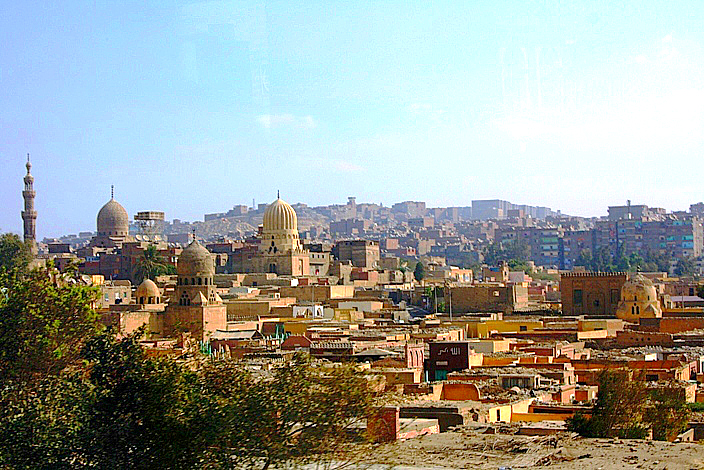
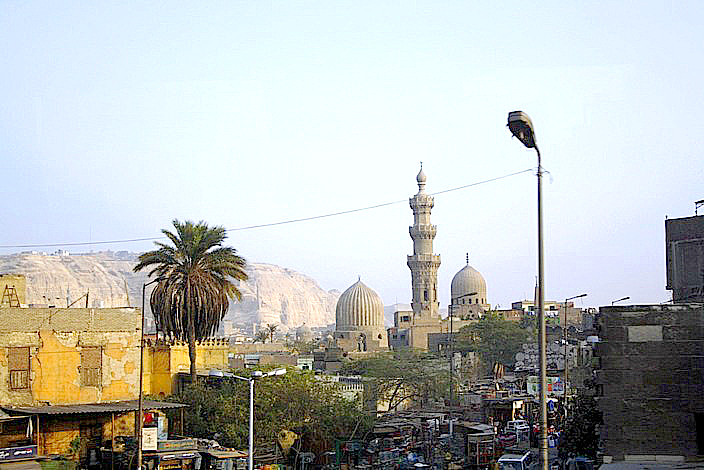
City of the Dead and nearby environs, a sprawling oasis of calm in the bustle of Cairo and an eery place even from the outside. Although offered the chance to see it from inside the idea of gawping at people forced to live in such circumstances didn't appeal, so we gawped at it from the outside only.
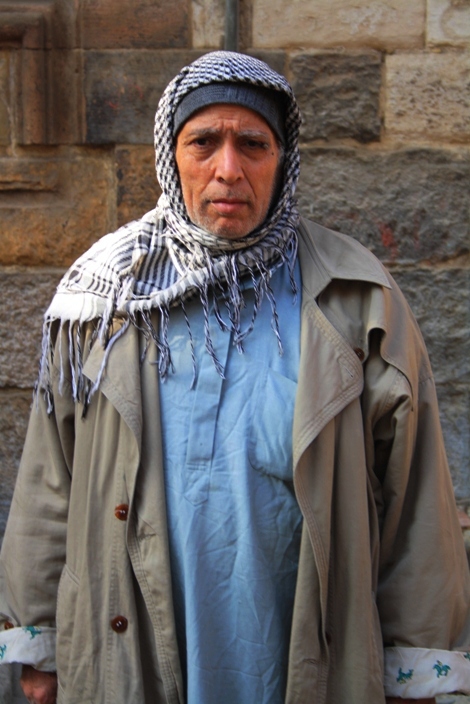
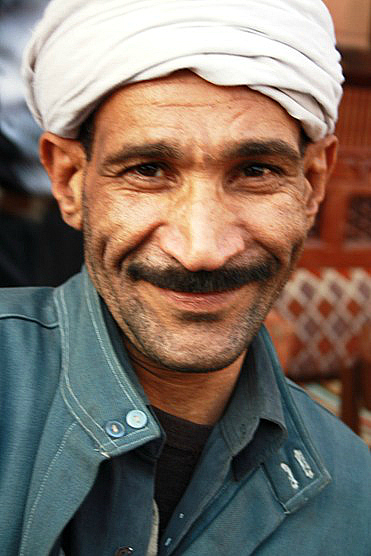
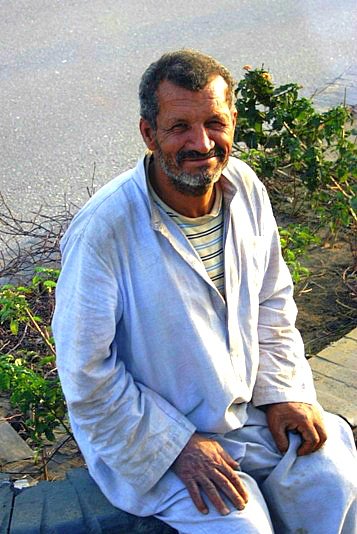
Faces of Cairo. Stallholder, Khan al-Khalili. Shoeshine, Khan al-Khalili. Taking a breather on the street.
Giza
Bucket List Rating 




Trash and Treasure
The creeping urbanisation of Giza from Google Earth. The Sphinx, middle right, watches as the desert disappears beneath concrete, asphalt and wind blown litter. What would the ancient Egyptians think of it?
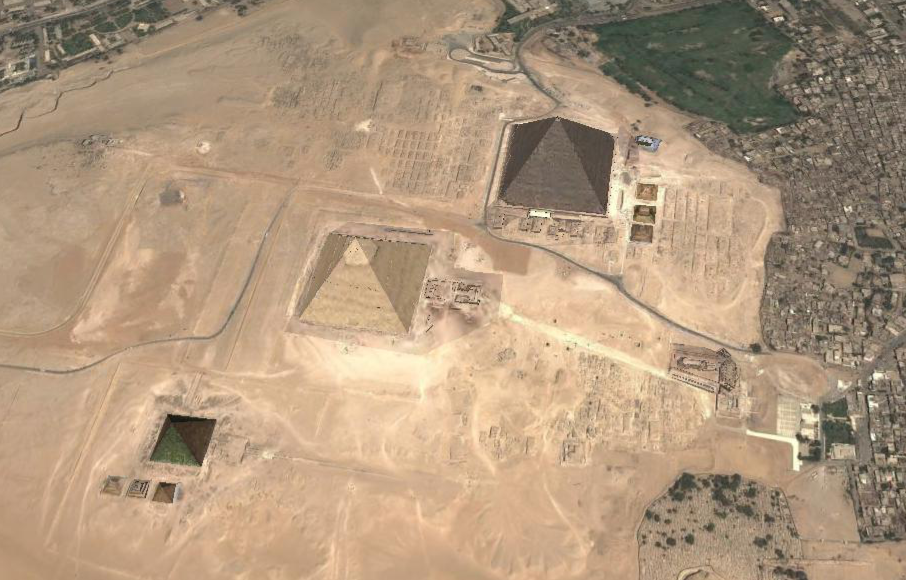
The largest of all and the earliest at Giza, the Pyramid of Khufu (the Great Pyramid) is at top right rising 147 meters above the plateau. Its 2.3 million stone blocks weigh from 2.5 to 15 tons. The first up-close sight of it from the drop off point (the asphalt circuit at the top of the picture) justifies the whole trip on its own - it is truly gobsmacking. Photos cannot do justice to its size - close up and only bits fit into frame, far away and the sense of its massivenes is lessened. The equally impressive Pyramid of Khafre (centre) with the remaining casing stones visible at its peak is in the middle, and the Pyramid of Menkaure, the smallest of the big 3 is at bottom. 6 much smaller Queens' pyramids can also be easily recognised.
Building bloody big pyramids ran in the family - Khufu was Khafre's dad and Menkaure's grand-dad. Khufu's own father Sneferu is responsible for the other 2 huge pyramids - the Red Pyramid and the Bent Pyramid at Dahshur about 40 kilometers further up the Nile.
There are famous and iconic destinations that can disappoint; not living up to the expectations that have grown from the hyperbole and superlatives that are applied to them. The Great Pyramids do not disappoint.
The pyramids are time machines
There's a lot of superstition and new age bollocks applied to the pyramids, but there is one suprising scientific fact: these monoliths are time machines. The closer an object is to a large mass, the slower time passes relative to objects farther away - and it's proven through the need to constantly adjust the time on GPS satellites where it travels faster than it does on earth. It may only be billionths of a second but it's a fact. So, if you want to age slower, go and live in the Great Pyramid - you'll gain a couple of fractions of a second of longevity. The catch is that if you lived in Egypt you'd want to die sooner.
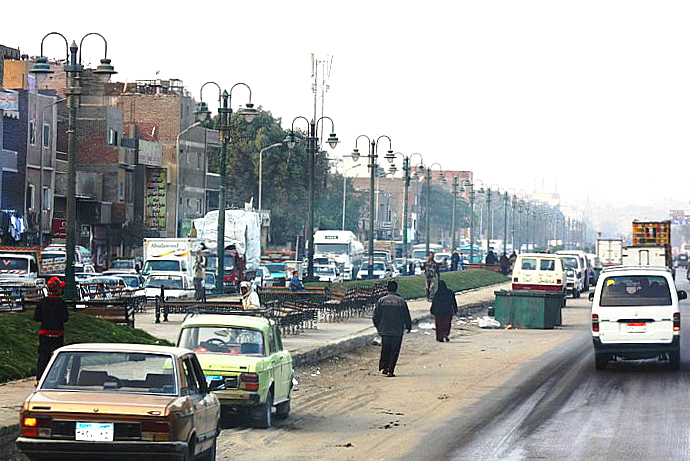
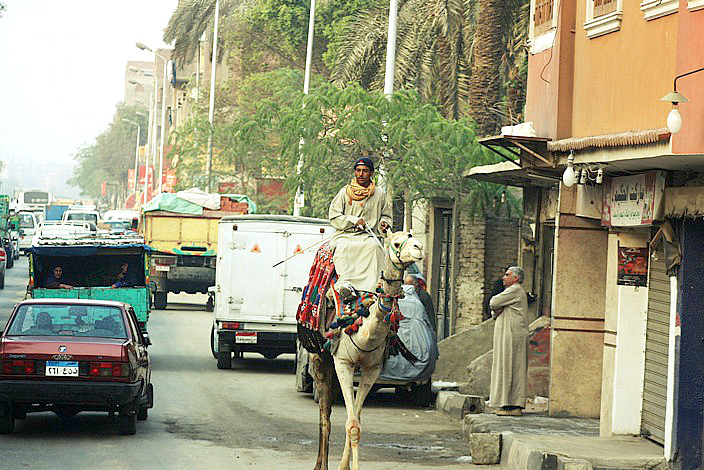
The main drag at Giza - the highway connecting Alexandria to Cairo and every bit as crowded, dirty and noisy as it looks. The 2 big pyramids' peaks loom up over the roofs of the buildings on the left (although not in the photo). A channel running between the 2 sides of the highway could be imagined as once being a tributary of the Nile used to transport the huge blocks for the Pyramids' construction. Today it's choked with garbage, occassional glimpses of water appearing between the detritus of modern Giza.
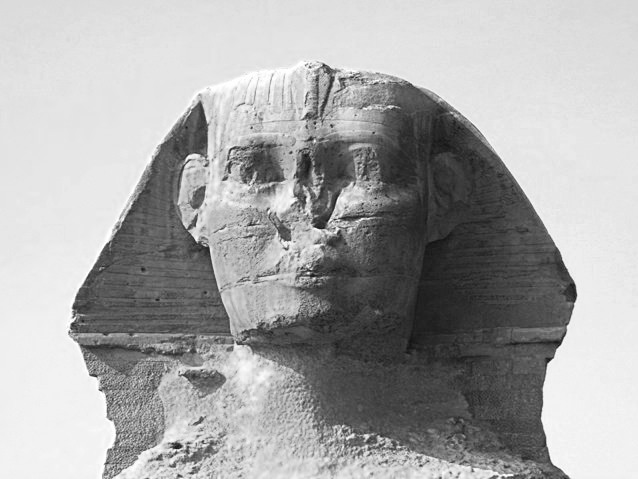
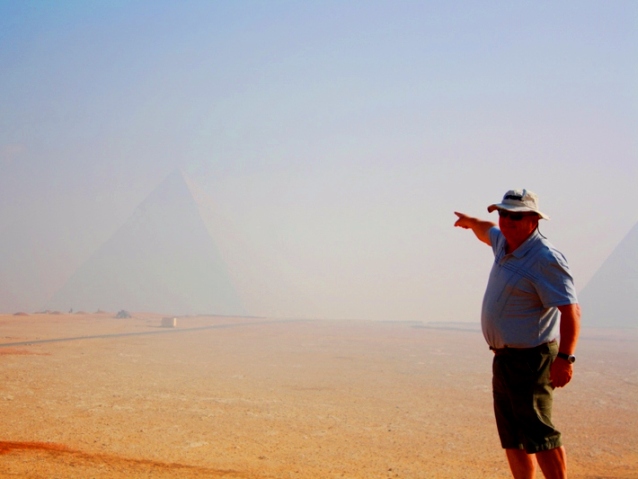
The inscrutability of the Sphinx. Surprisingly, and alarmingly, tourists are allowed to climb on parts of it. The story of Napoleon's troops using it for target practice and shooting its nose off are apparently a myth - paintings from earlier times show it with a missing nose. An awful lot of ancient Egyptian statues and figurines have missing noses. Chatter on the internet (now there's a reliable source) claims that white guys (WTF? White guys? Romans?) smashed them off because they had black African features. But look at Tutankhamun's gold mask, the bust of Nefertiti and the Ramses statues at Abu Simbel - all with noses intact and none showing any particular racial characteristics. Sounds like bollocks to me.
Bruce points to the Great Pyramid lost in the sand and smog haze in the background. What can't be seen either is the ankle deep rubbish he is standing in, or the Pizza Hut that the Sphinx stares towards. Ancient monuments have been ransacked, broken apart for building materials, built over and used as dumping grounds. Islamic nutters in the short-lived Morsi government wanted to cover all ancient artefacts because they found them offensive to Islam, and rioters dragged Rameses mummy into the street and tried to destroy it. And the Egyptians complain from time to time that other countries won't return ancient treasures!
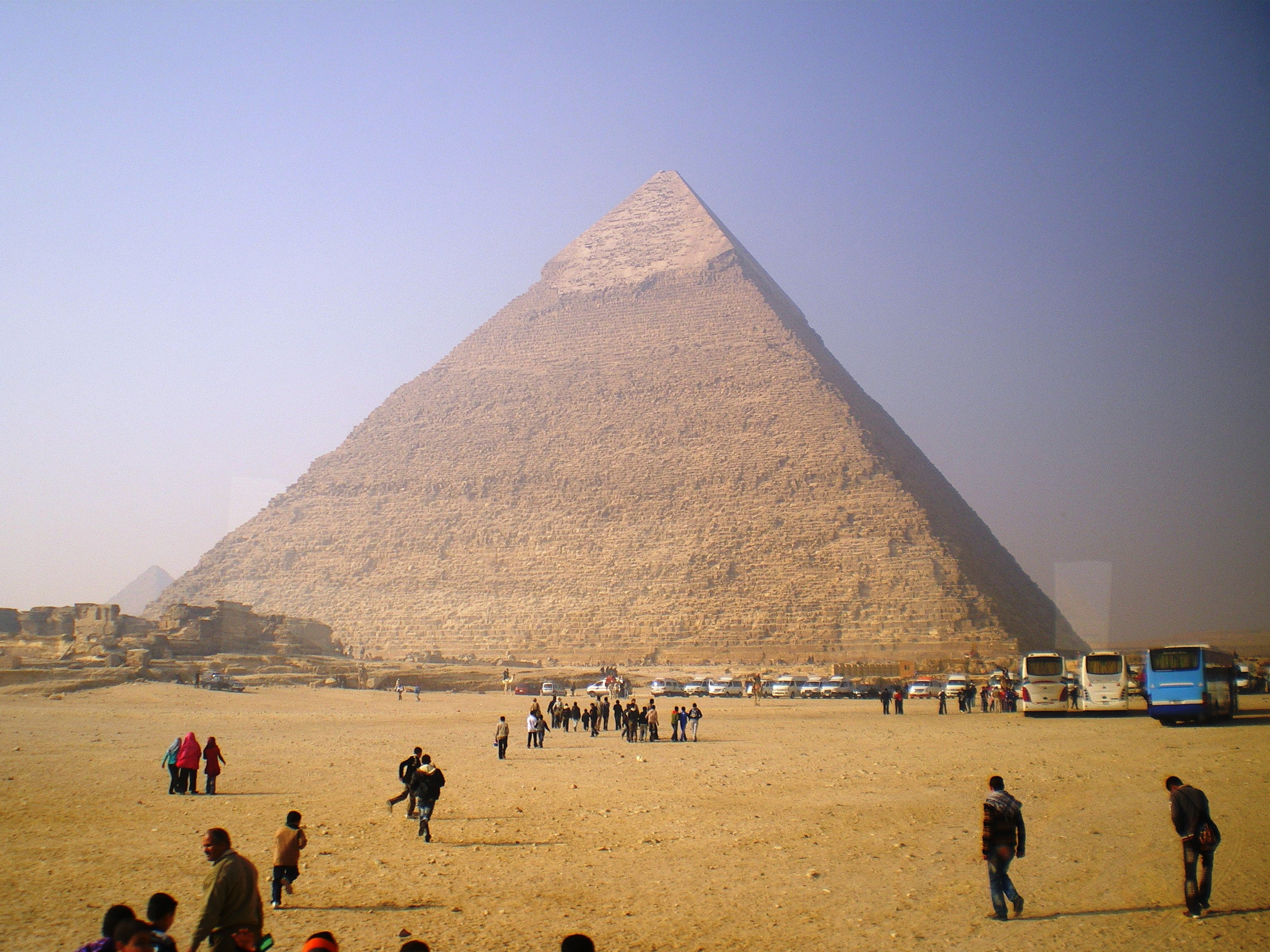
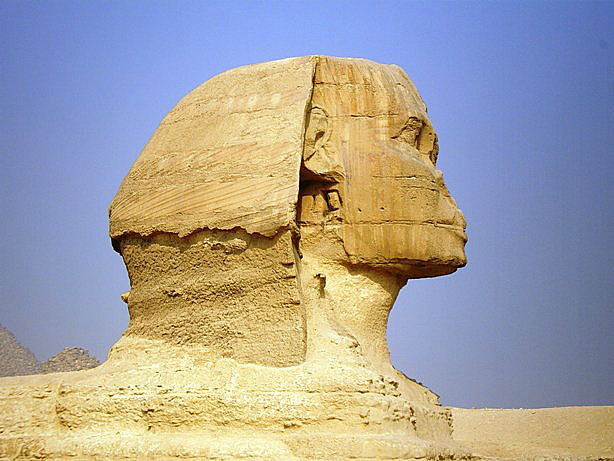
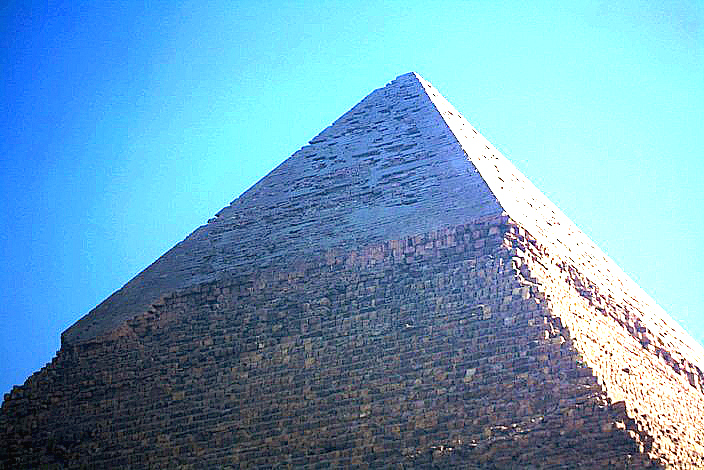
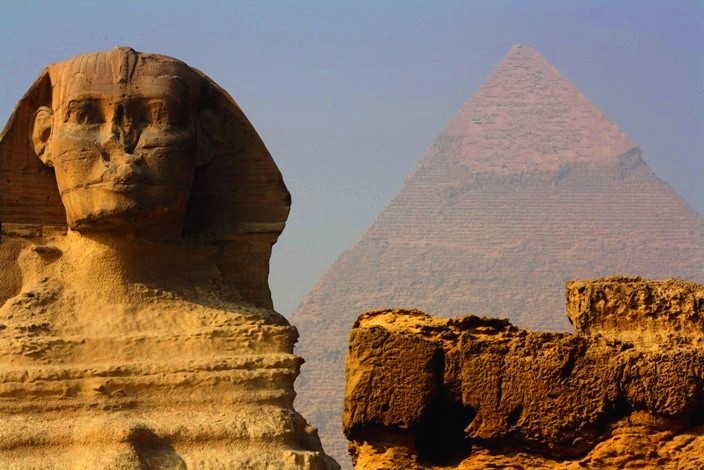
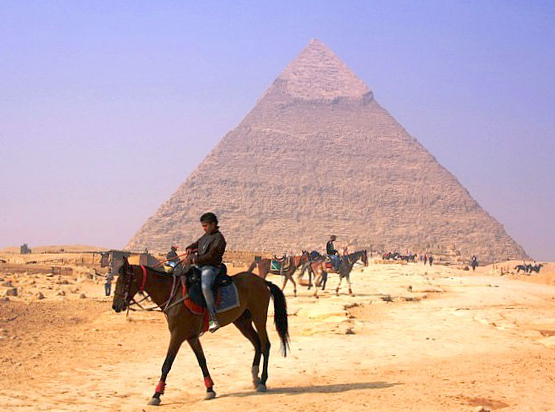
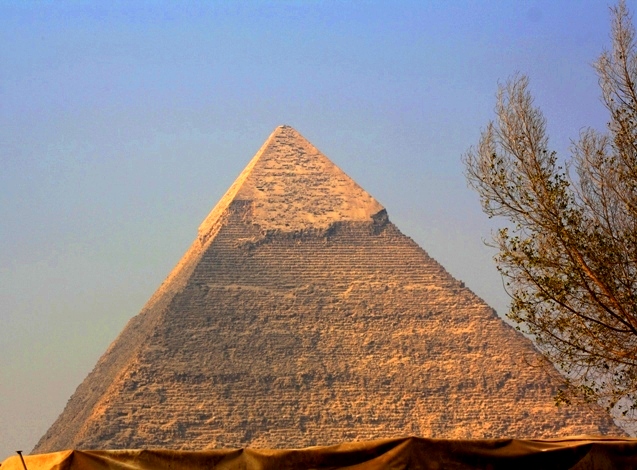
Sphinx and the Pyramid of Khafre showing the remaining limestone capping at its peak.

The Great Pyramid of Khufu from over the Sphinx's back. The Pyramid of Khafre is directly behind the Sphinx.
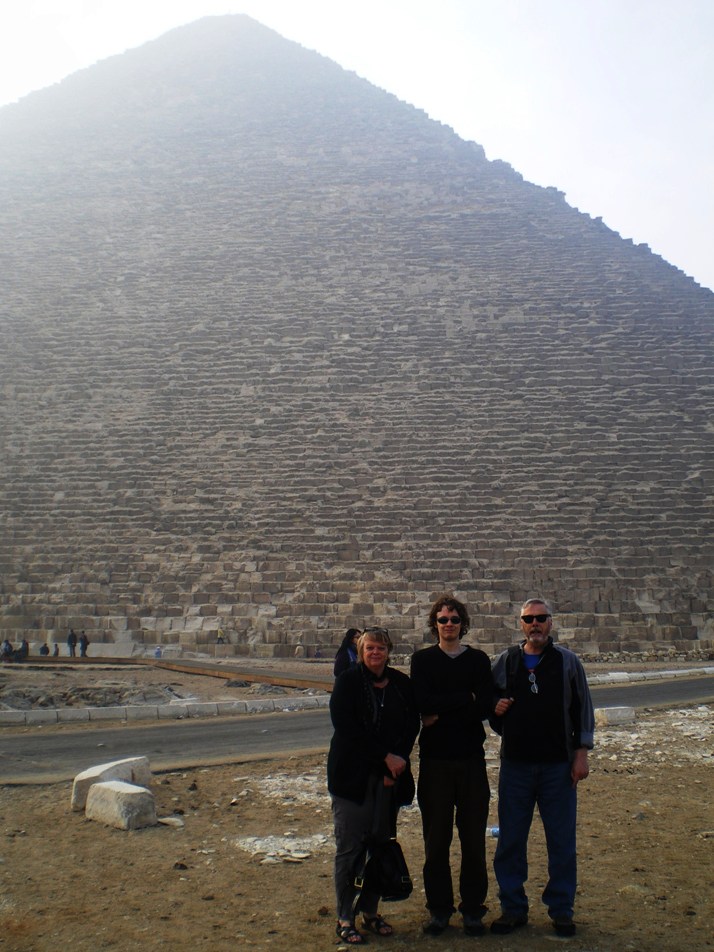

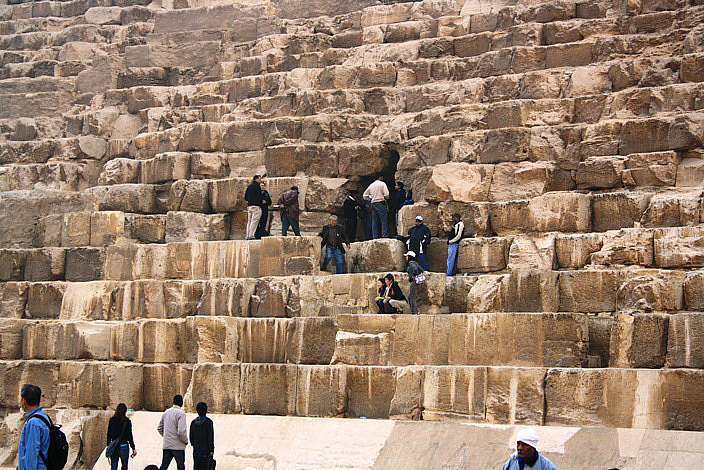
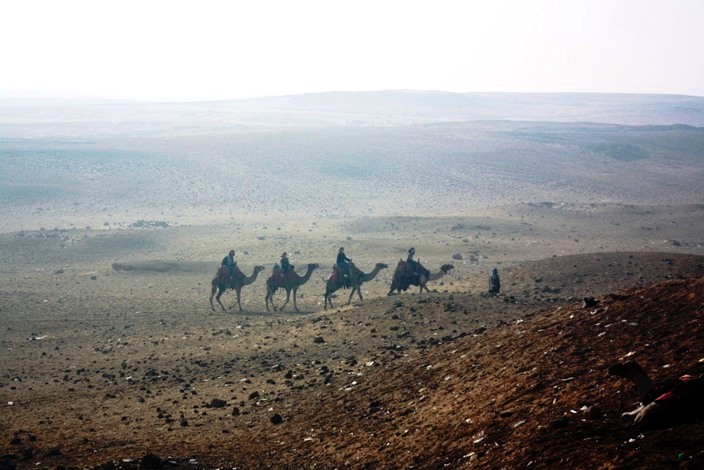
The entrance that leads up to the Kings Chamber in the core of the Pyramid of Khufu - the Robbers' Tunnel dug by workmen employed by Caliph al-Ma'mun around 820 AD. Even though the chamber is relatively small and claustrophobic and empty except for a granite sarcophagus, the spookiness of being in the middle of that huge mass makes the steep, squeezy climb worthwhile.
What Giza must've once looked like from all angles. Tourist camel rides near the Pyramids.
Memphis - Saqqara
Bucket List Rating 




Pyramid central
Memphis, capital of ancient Egypt founded around 3,000 BC and an important centre during much of Egyptian history. About 24 km south of Cairo and a designated UNESCO World Heritage site.
Other than the small, mostly outdoor museum there's not much of ancient Egypt that is still evident in Memphis, and not much of anything else either apart from small shops and stalls near the museum amid Mit Rahina, modern Egypt's version of a small country town. Various temples and palaces once abundant at Memphis have been mostly destroyed, much of their contents distributed about the place. It's still well worth visiting as close by where the fertile Nile river banks give way to desert in an abrupt line are the necropolises in the pyramid fields of Saqqara with Abū Ṣīr and Dahshūr not very far away.
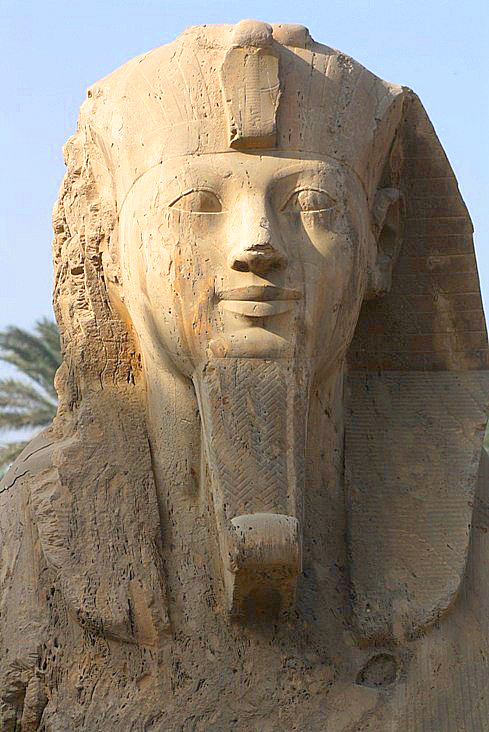
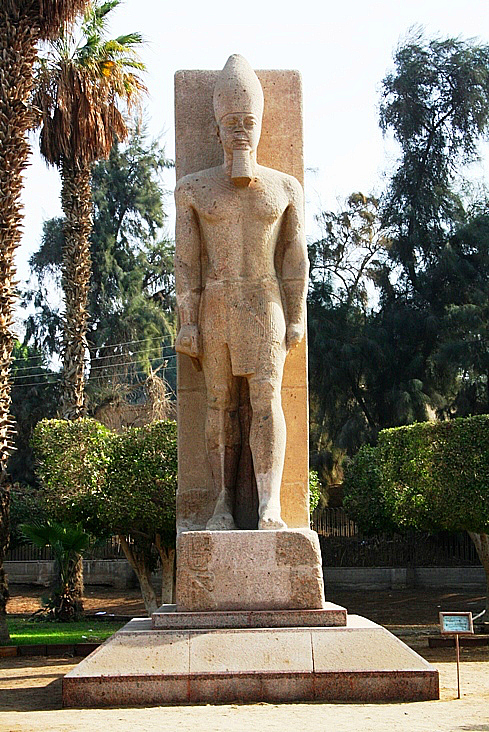
The Alabaster Sphinx of Amonophis II (left) aka Amenhotep II. This much smaller scale sphinx gives some idea of what the face of The Bloody Big Sphinx at Giza may have looked like before its nose and beard got chiselled off and its face got weathered. If Moses did lead the children of Israel out of Egypt during the reign of Amenophis II, then the main oppressor of Israel would have been his father Thutmose III who was also the greatest conqueror in Egyptian history. His sister Queen Hatshepsut, she of the impressive temple near Karnak, could've been the rescuer of Moses and brought him up.
Rameses II (right). The same bloke as is represented in the monolithic temples at Abu Simbel. 2 statues of Rameses and the sphinx are the most imposing of the relics at the mueseum - one of the Rameses statues is huge - 10 metres long (yes - long; he's lying on his back because his feet are missing) and carved from one block of limestone. The museum was bulit to protect it. Adjoining the museum enclosure, in what could fairly be called a paddock are several large, 5 metre long embalming tables - used for the bulls that led a pampered life and were ritually mummified and placed with great ceremony in the Serapeum at Saqqara, the burial place of the Apis bulls located near the Pyramid of Djoser.
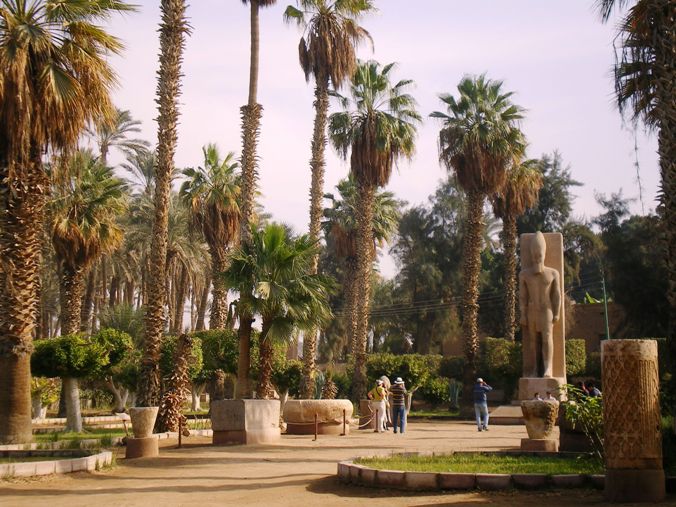
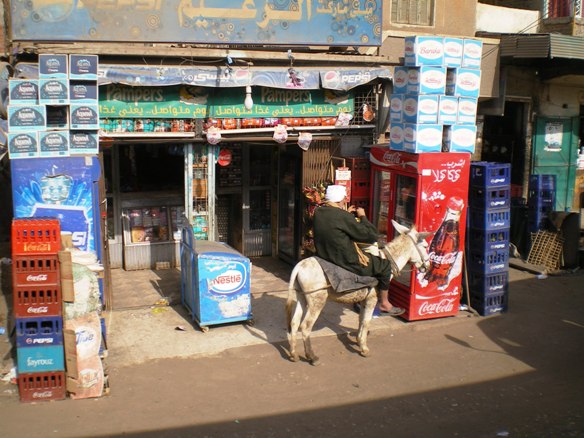
The museum grounds and Mit Rahina, small town Egypt.
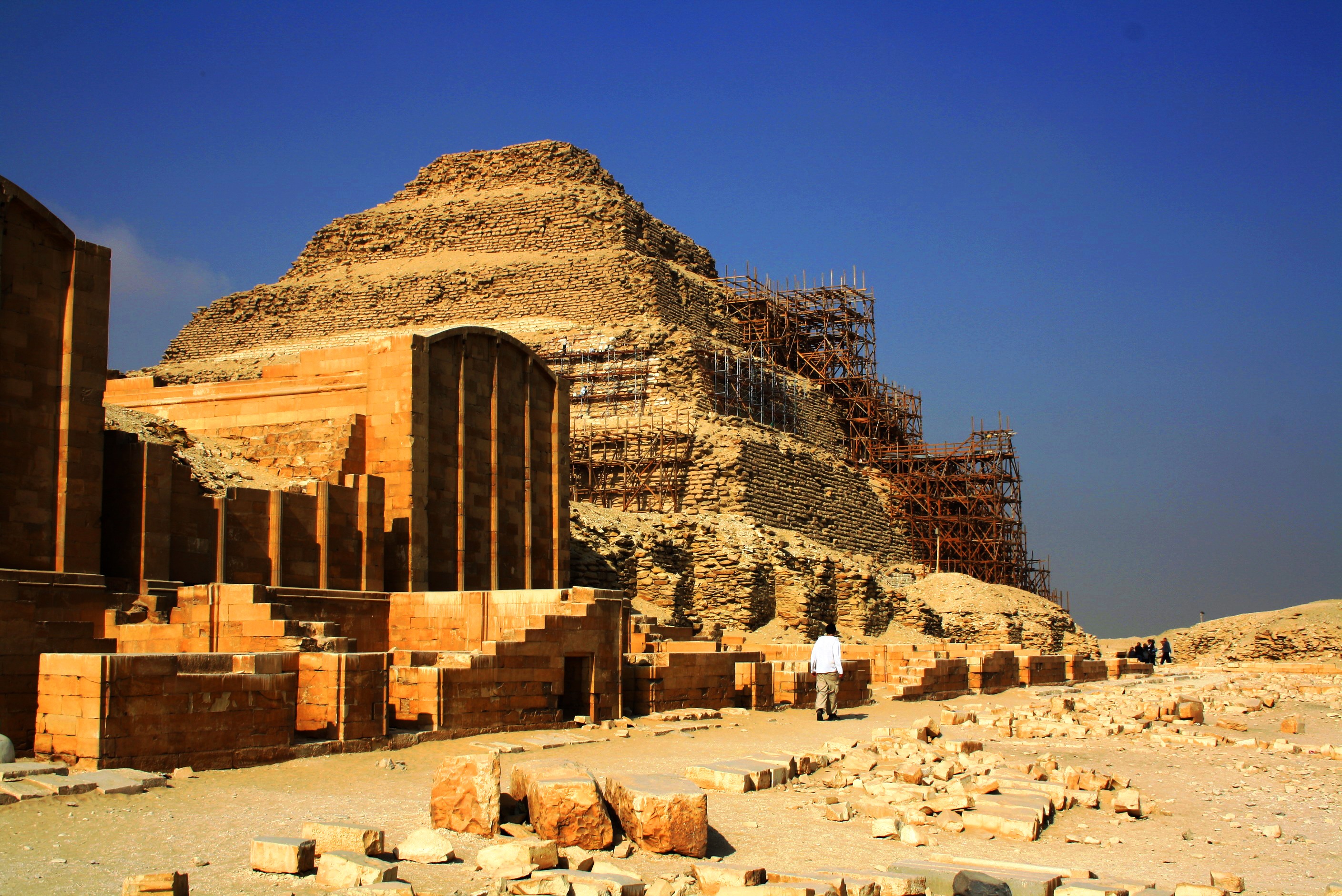
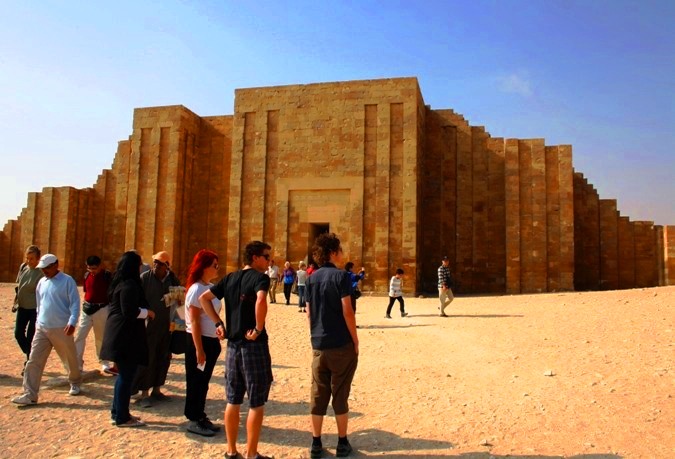
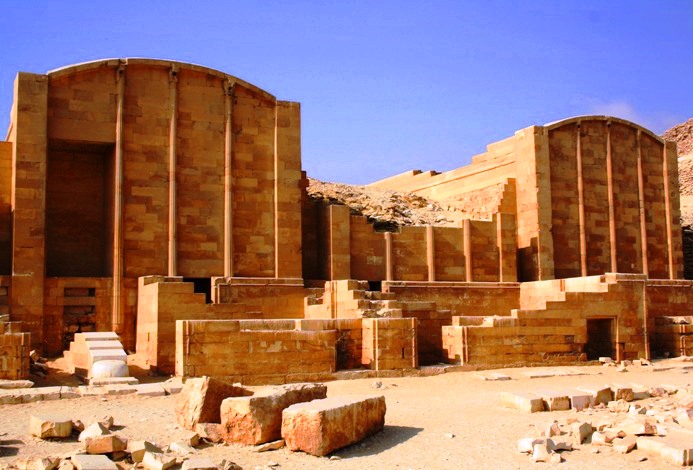
The first of the pyramids, the Stepped Pyramid of the pharaoh Djoser was built in the 27th century BC at Saqqara near the then capital of Memphis. While there were several pyramids constructed in the intervening years, the next ones of real note are the Bent Pyramid and the Red Pyramid, both constructed by the minions of the pharaoh Sneferu at Dashur, close by and visible from Saqqara.
Snef was a bit of an over-achiever in the pyramid building game having also put up the first non-stepped pyramid, at Meidum, as his first attempt. It is thought possible that old Snef remains undiscovered somewhere in the midst of the Red Pyramid. He passed his pyramid-building genes on to his son Khufu, the brand owner of the Great Pyramid at Giza, and his grandson Khafre – he of the second-biggest pyramid you ever will see.
The pyramid fields (containing 118 - 138 pyramids depending on your sources) stretch along the desert edges abutting the green western bank of the Nile, from the southern perimeter of Cairo at Abu Rawash and Giza to Meidum 90 kilometres to the south. While Giza is the must-not-miss main attraction, Saqqara, Abū Ṣīr and Dahshūr have significant clusters of pyramids from the monolithic such as the Red Pyramid and Bent Pyramid to those that are now not much more than mounds of rocks and dirt.
Luxor - Karnak
Bucket List Rating 




The Thebes of ancient Egypt - the capital of the Middle and New Kingdoms. The temples and palaces of Luxor and Karnak built on the east bank and the necropolises of the Valley Of The Kings and (mis-named) Valley Of The Queens on the west side as was ancient Egyptian custom - the living on the east where the sun rose, the dead on the west where it set.
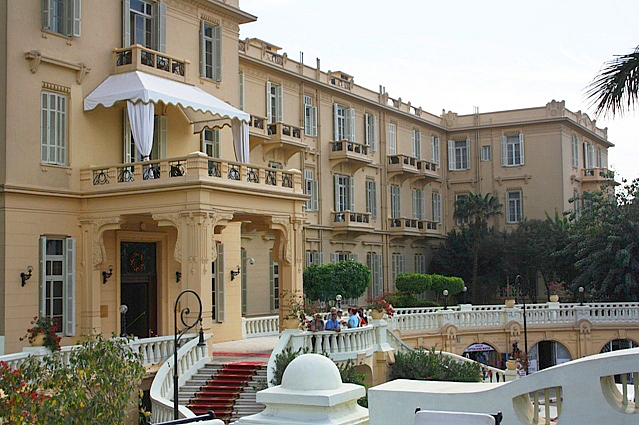
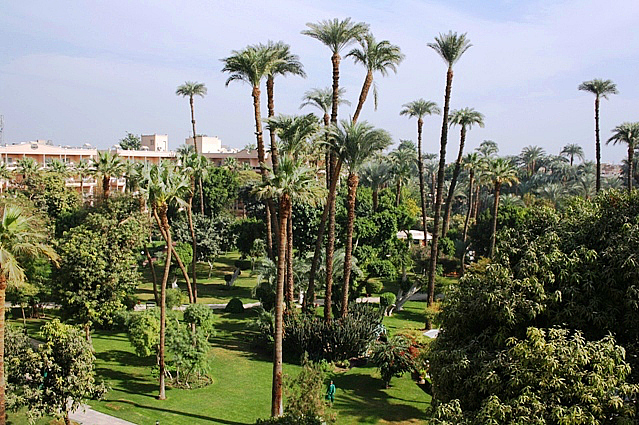
The Winter Palace Hotel (front and back) on the east bank of the Nile, built in 1886 by British colonialists and looking the part, including the dapper and oh-so-English Daphne & Roger who we chatted with on the back terrace. Roger looked like one of the original builders of the hotel returning for a top-up of the preservation techniques used by the ancient Egyptians. I think Daphne kept him in the wardrobe and wheeled him out once the sun lost some of its strength. You may find Roger still there propped up in amongst the coathangers if you drop in for a stay.
The hotel is a fantastic Olde-Worldy base for exploring the whole area - the temples of Karnak and Luxor, Colossi of Memnon, Rameses II's Ramesseum memorial temple, Temple of Hatshepsut and the Valley of the Kings and Valley of the Queens. The Hotel faces the Nile and across green, flat farmlands to the desert escarpment where the Valley of the Kings is tucked away. The hotel is also notable for being the site of Sean's 1st number 2 in Egypt. It must've been a biggy - luckily the following parts of the trip were up-stream.
Karnak Temple. The site of futile rituals that celebrated non-existant deities
We wouldn't do that in more enlightend times, would we? At least religion stimulates impressive architecture.
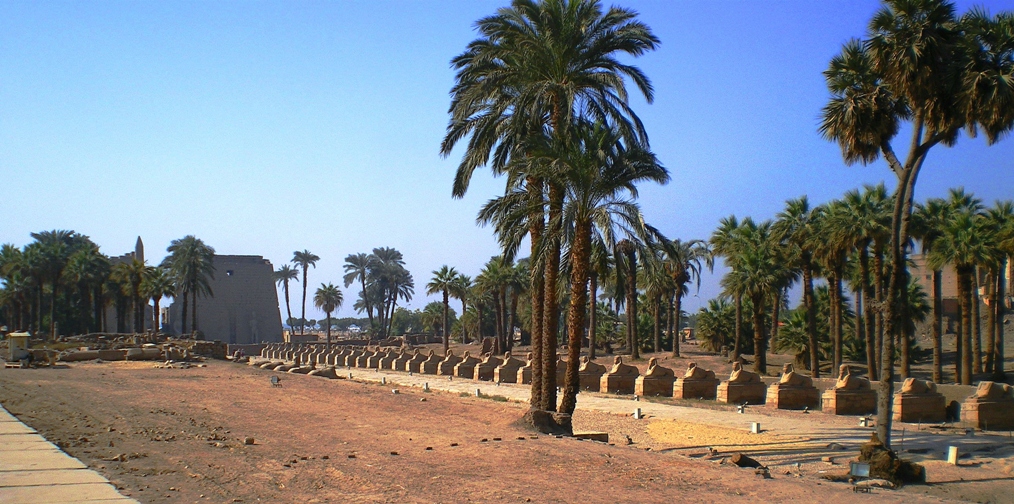


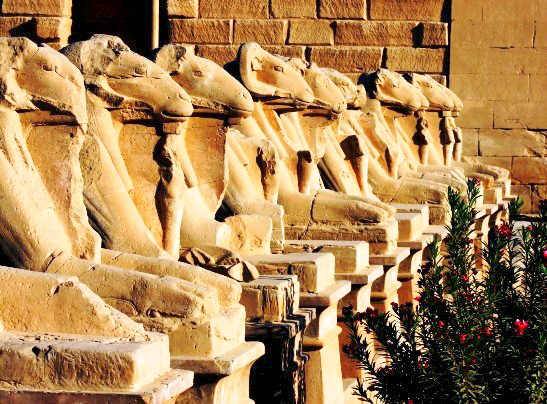
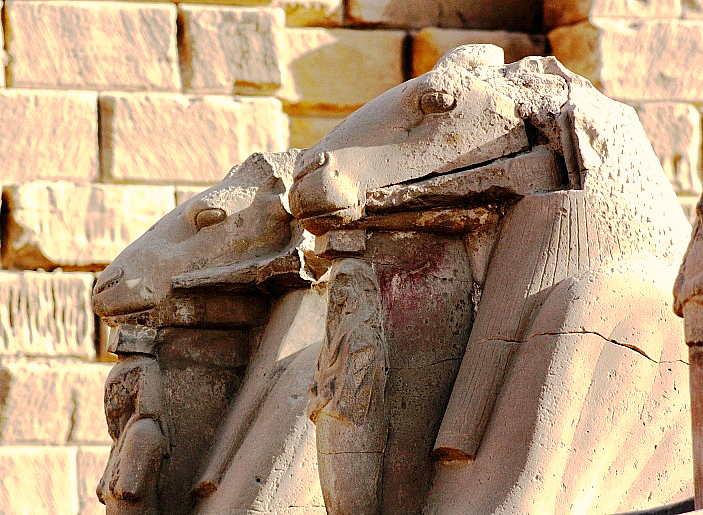
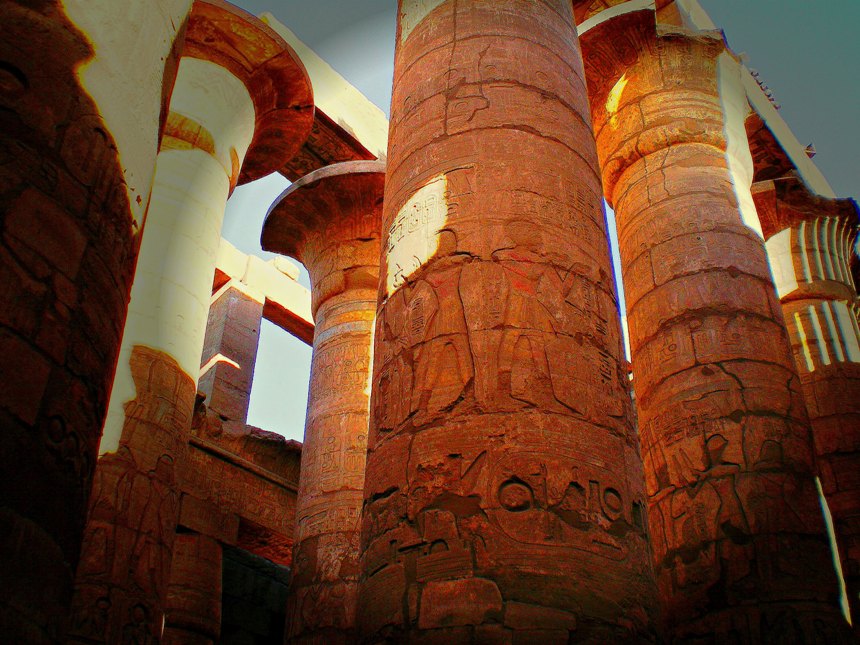
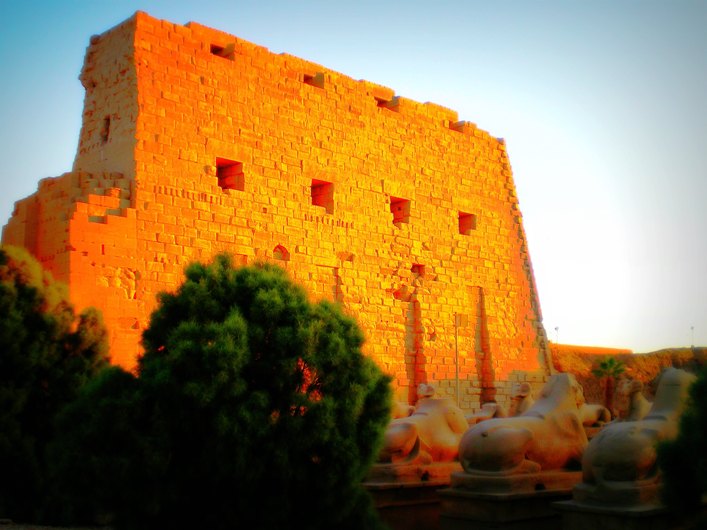
The Karnak Temple complex (above) adjoining Luxor and its temple and connected together by an aqueduct now partially overbuilt. The complex is a vast open-air museum and the largest ancient religious site in the world if we overlook Angkor Wat in Cambodia. In use across the reigns of 30 or so paroahs it has a complexity and diversity not seen in any other ancient Egyptian temples, and has accommodated a range of deities as religious tastes changed.
Colossi of Memnon (below, left). The twin 18 metre statues depict Amenhotep III, 3,400 years old and re-assembled after being destroyed by earthquakes and floods.
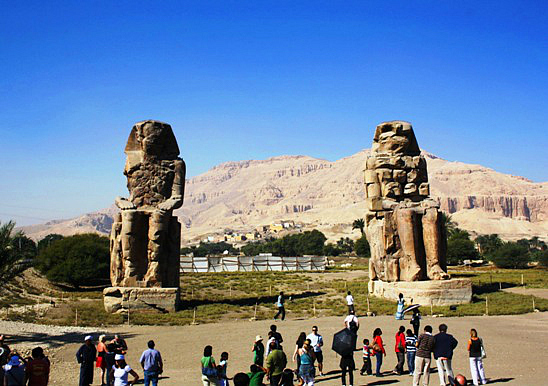
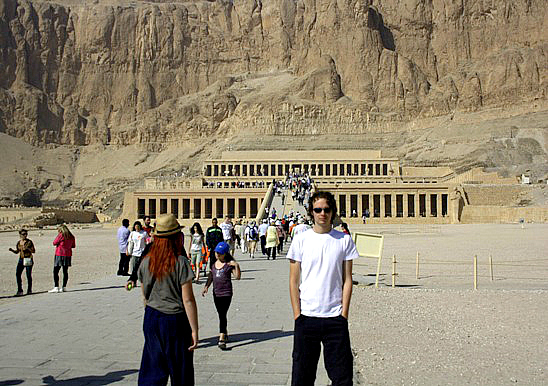
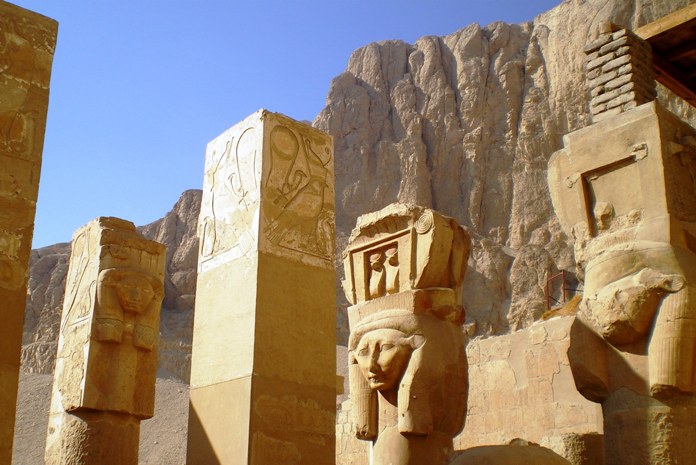
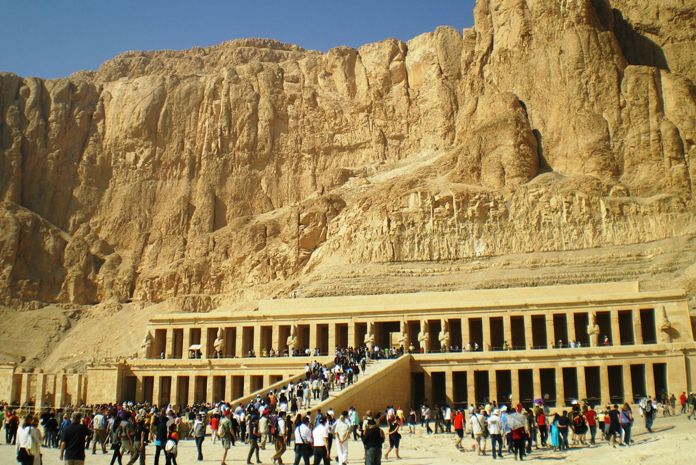
Temple of Hatshepsut, built for one of the few female pharoahs to commemorate her achievements and to serve as a funerary temple for her as well as a sanctuary of the god Amon Ra with some brilliant hieroglyphs with colours still quite vivid.
The Valley of the Kings, while a 20 minute bus ride away, is just over the escarpment behind the Temple. No photography is allowed at the Valley of the Kings - you've got to buy any photos from the various gift shops clustered around the exit. That's really annoying, as were the in-your-face touts trying to extract our money on our way out - the real curse of the pharoahs.
The Valley Of The Kings is 2 valleys - the West Valley and the East Valley which has 59 of the known 63 tombs. The latest discovery was as recent as 2008. Who knows what still remains hidden? Hiding dead pharoahs away in buried tombs was a habit of the 18th to 20th dynasties, well after the pyramid-building ostentation of the mostly 3rd to 4th dynasties of 1,000 years earlier. It's intriguing to ponder the fact that as they placed Ramses II into his tomb in the Valley Of The Kings the pyramids at Giza were already ancient.
The big names of the pyramid craze were the pharoahs Djoser, Sneferu, Khufu, Khafre and Menkaure, while Rameses II, Tutankahmen, Seti, Arkenahten and others were put underground in complexes that were covered over and were intended to remain hidden forever. The Valley was in use from the 16th to the 11th century BC. So, by the time of the last internment, the earliest mummy (Tuthmosis I) was already 500 years old. Ramses II was fond of monuments to himself (Abu Simbel being just 1 example) so it's no real surprise that his tomb is the biggest at 120 rooms (and still being excavated).
The Nile. Luxor to Aswan
Bucket List Rating 


The world's skinniest country
Egypt is the largest of the Middle Eastern countries and the 3rd largest in Africa. In reality though it's really a very narrow ribbon of green through vast empty deserts terminating in the triangle of the Nile delta where most of the population lives
Egypt's life blood since before the pharoahs the Nile is now dammed at Aswan by the Low Dam of 1902 and again by the High Dam built in the 60s to control flooding which fertilised the river banks and farmlands. Now the Egyptians have to use artificial alternatives. God knows what they'll do if any of the upstream countries that 80% of it flows through decides to start sucking large volumes of water out of it.
A river boat is the ideal way to travel. While the Nile may be the world's longest river, and discharges something like 3 million litres per second it flows by at a placid looking pace. Hundreds of boats used to traverse its length, most being idle now due to the plunge in tourist numbers. But, the river banks glide by offering a slow-paced way to observe and photograph the country from the top decks. While Egypt is the most populous of middle eastern countries and 3rd on the African over-crowded index where almost all 85 million Egyptians live along its banks, most of it still looks agricultural. Luxor to Aswan is a 2 day journey by boat, overnighting at Edfu and a visit to its Temple Of Horus a couple of blocks back from the river. Awoken at Edfu after the night on board by loud yelling and excitement that sounded like a riot directly outside our water-level window. It turned out to be a swarm of local vendors on small boats throwing their wares to tourists on the top decks amongst a cacophony of shouted price negotiations. What a racket!
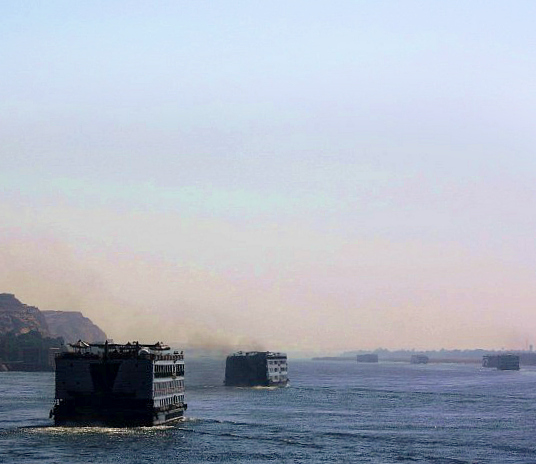
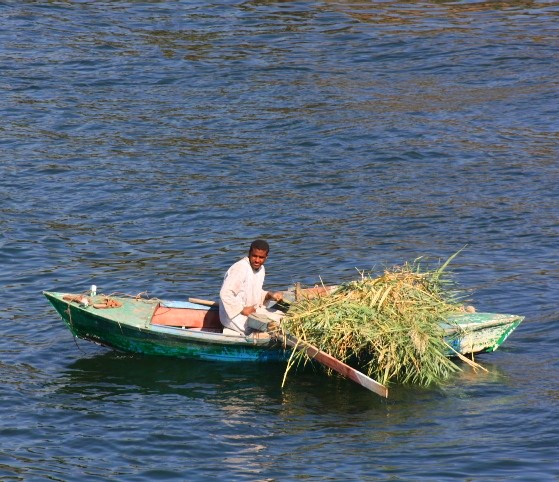
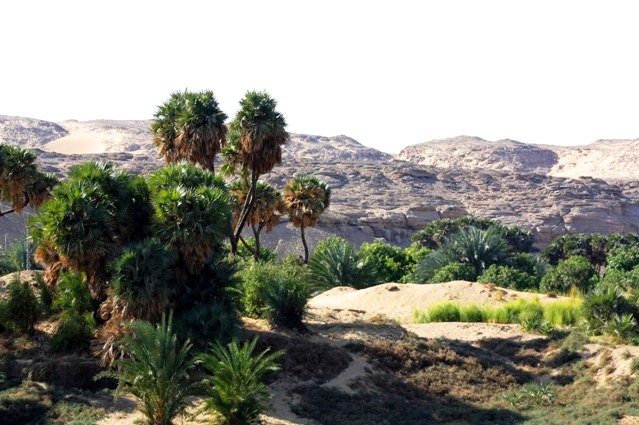


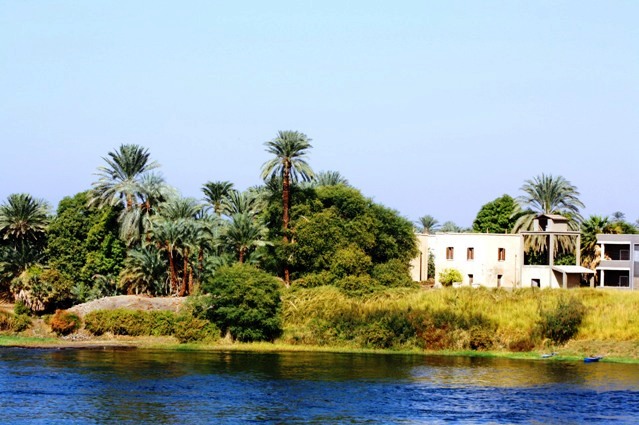
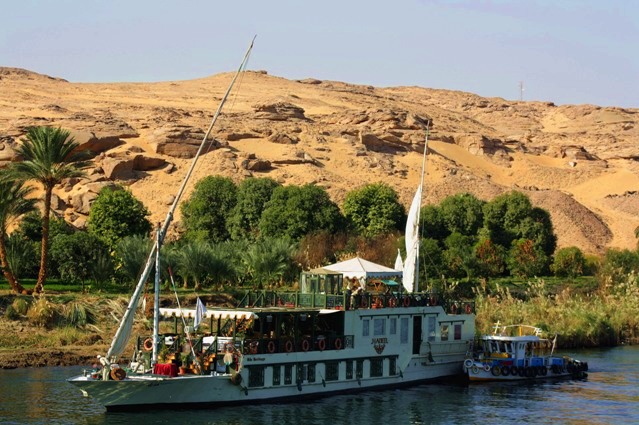
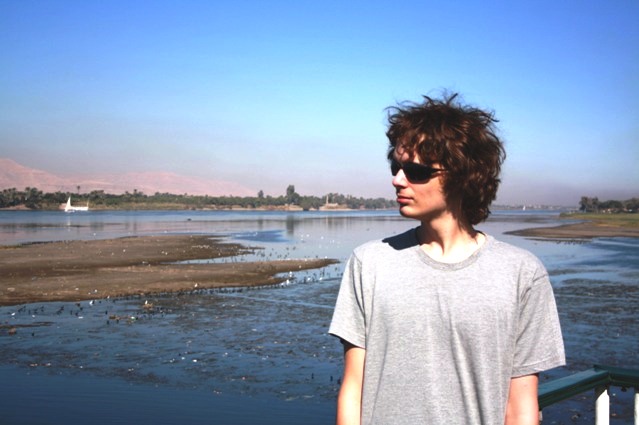
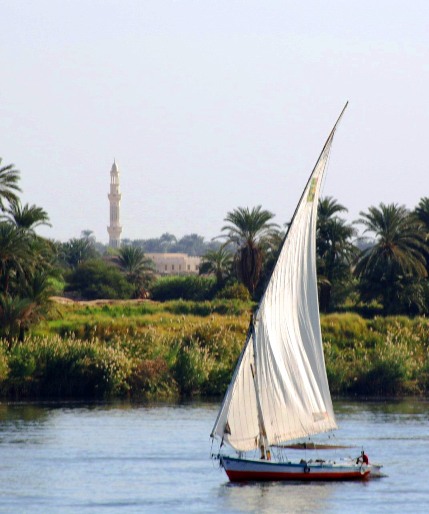
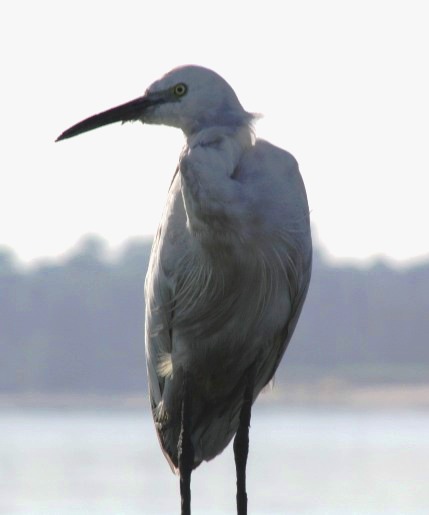
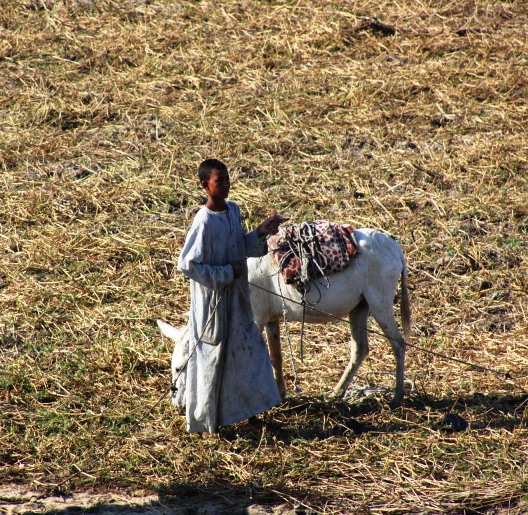
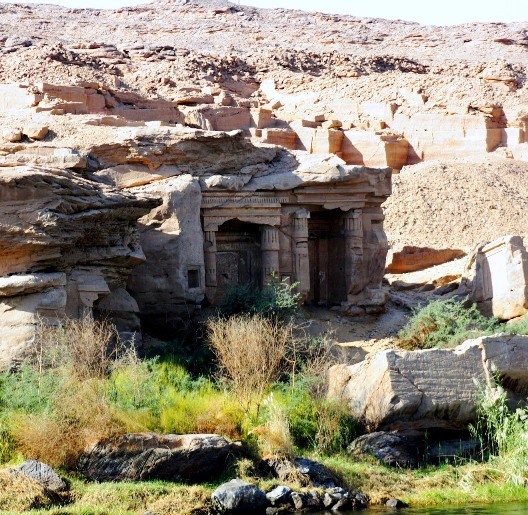
Green where the water reached along the river fringes with a backdrop of sun-blasted desert. The height of the river banks varied, receding back a few kilometres in some places and reaching right to the edge in others. Seemingly sparsely populated for the most part with occassional small towns gliding into view. A railway line runs along most of the river length - but a boat trip would be far more relaxed and scenic.
Temple of Horus at Edfu
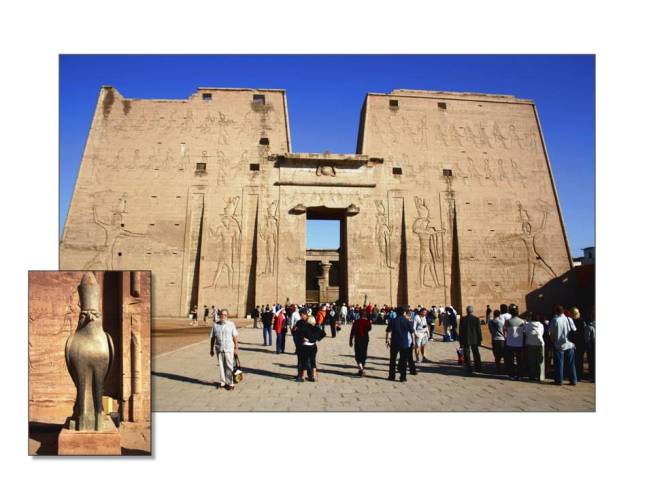
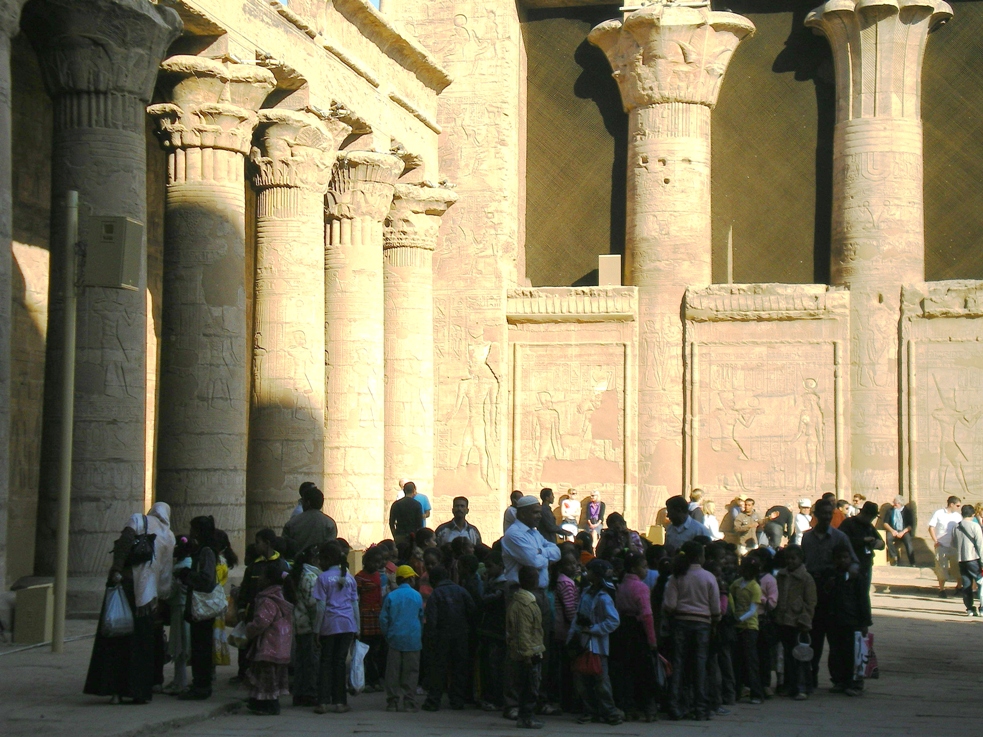
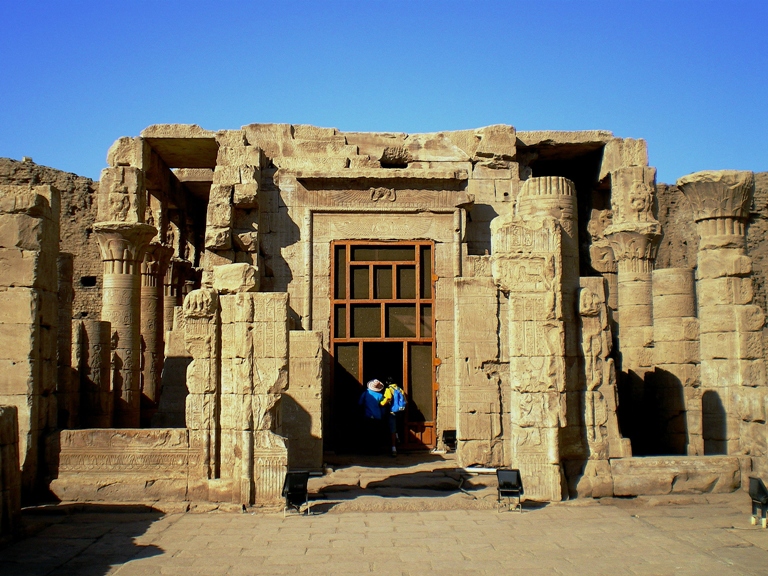
Edfu. Temple of Horus, the falcon-god. Building started in 237 BC and was finished 200 years later by Ptolemy XIII, father of Cleopatra. Edfu temple is one of the best preserved temples in Egypt. When the first clearance of Edfu Temple in 1860 was started the temple had become a village filled with stables and storehouses, the roof of the sanctuary area was covered in mud-brick houses and the inner chambers were filled with rubbish almost to the ceiling.
Edfu is reached by boat after traversing the Esna Locks about 40 kms downstream, at about the halway point. Even with a greatly reduced volume of river traffic the locks are kept busy with lots of shouting, shunting and waiting.
Aswan
Bucket List Rating 
Aswan (below left). Opposite banks of the Nile, with the town on the east bank and hot and dry sand covered banks directly opposite.
A float in a boat (below right) to the rocky shallows for a visit to a Nubian village below the Aswan Low Dam.
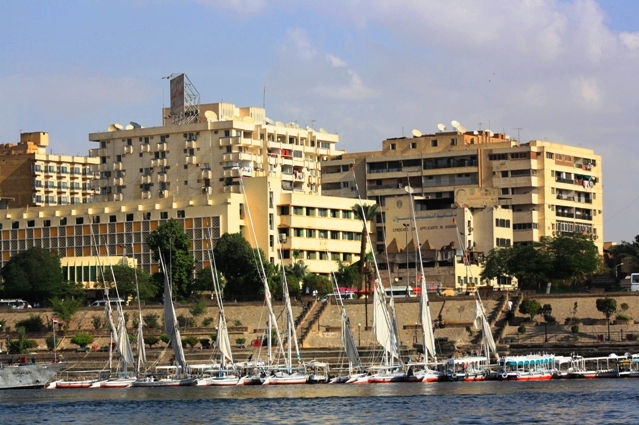
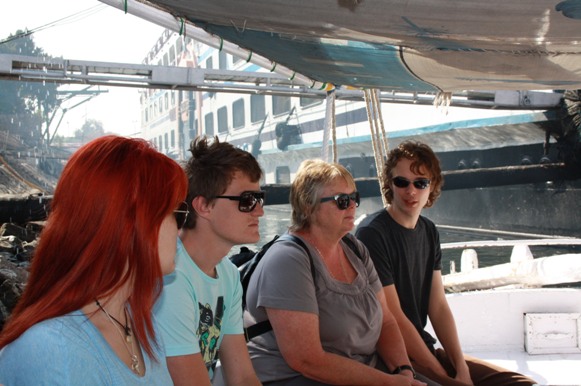
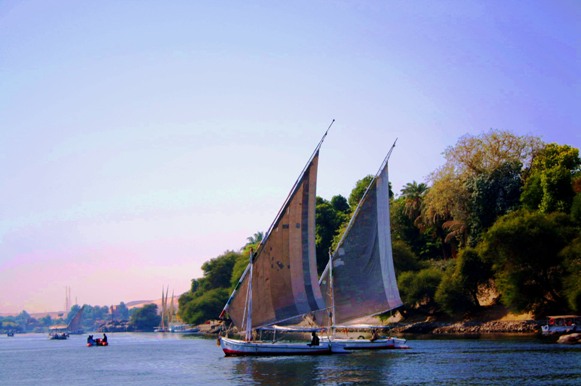
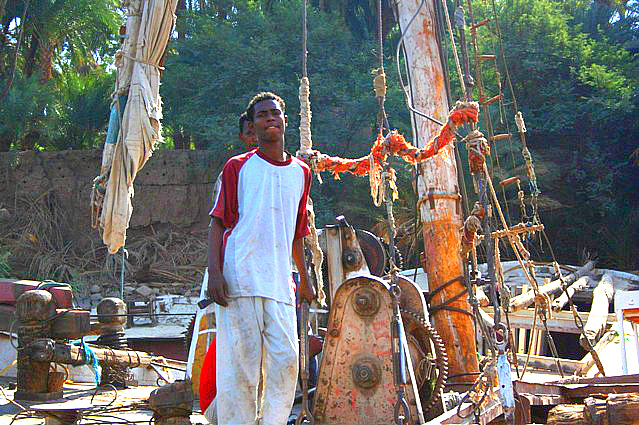
(Above left) Elephantine Island, the largest of the area's islands at the first Cataract of the Nile which provided a natural boundary between Egypt and Nubia - now a part of southern Egypt and northern Sudan. A Nubian village on the Cataract where the laidback inhabitants are happy to sell a cold drink or a souvenir without getting in the least bit pushy.
(Above right) Nubian fellucamen - cool lookin' dudes, young or old.
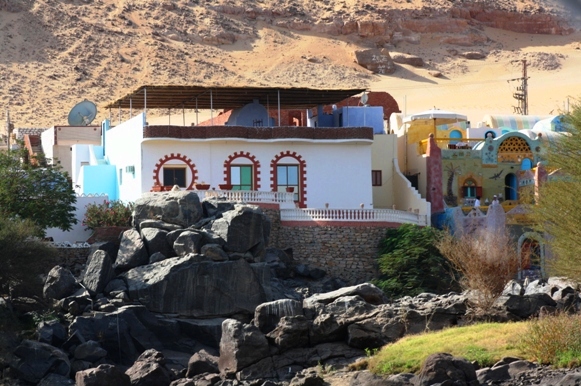
Nubian village - west bank of the Cataract on the rocky shallows just below the Aswan Low Dam.
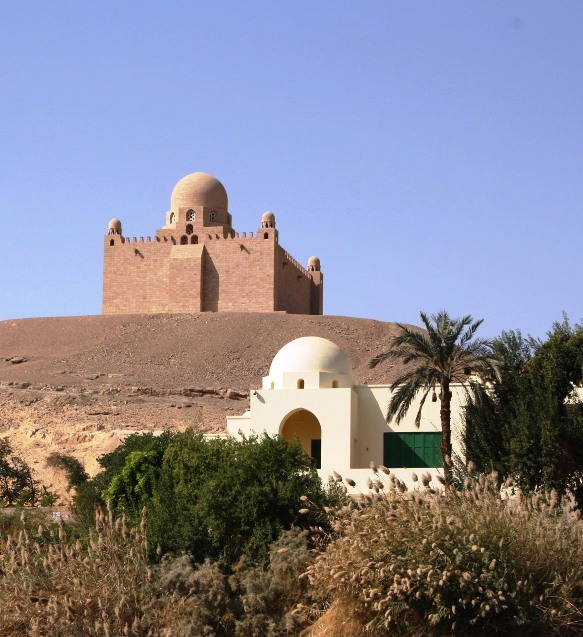
The tomb of "some Pakistani", we were told, who thought imitating the ancient Egyptians would faciliate his entry to the after life. It's the Mausoleum of Aga Khan III, who pushed for an independent state for muslims in India - hence the "Pakistani" label.
Abu Simbel
Bucket List Rating 




The almost-drowned treasure of the Nile
Egypt was prepared to sacrifice Abu Simbel. Luckily the rest of the world was not.
Abu Simbel is 2 temples cut into the rock face - the Rameses / Remesses Temple and the Temple of Nefertari. Built in the 13th century BC, they were cut into pieces and re-assembled higher up through UNESCO sponsored intervention in 1968 to escape the rising water after the construction of the Aswan High Dam, over 300 kms away. A short plane ride from Aswan is the easy way to get there with excellent views of the huge lake formed by the dam.
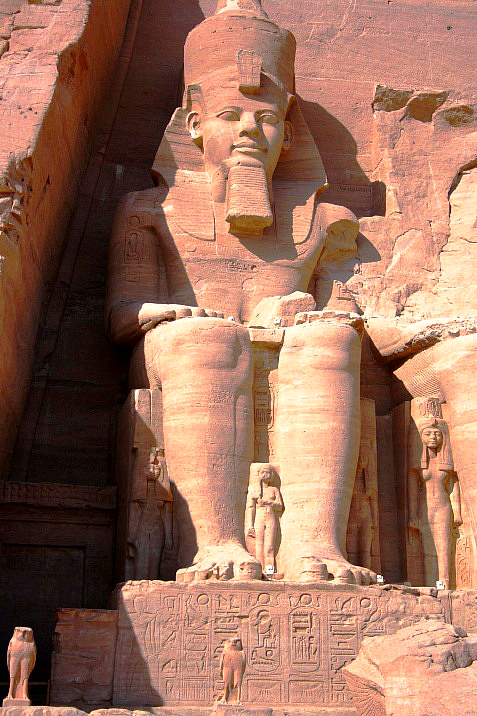
Rameses reigned 1279 BC – 1213 BC. He is believed to have taken the throne in his late teens and is known to have ruled Egypt from 1279 BC for 66 years. He supposedly lived to be 99 years old and was buried in a tomb in the Valley of the Kings.
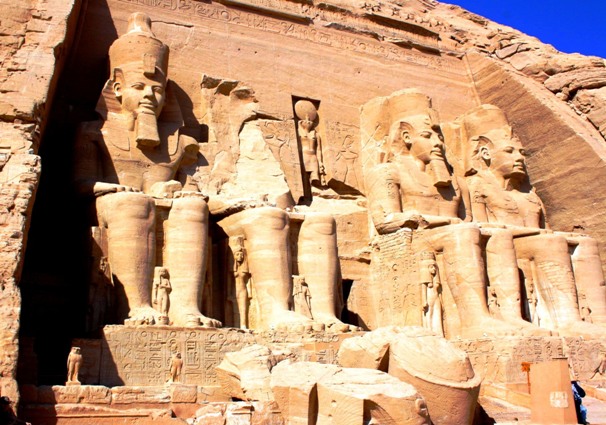
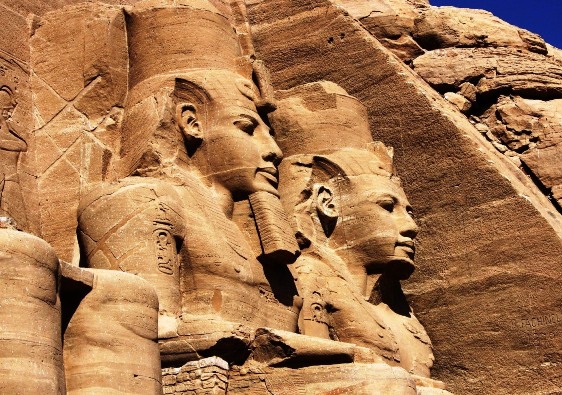
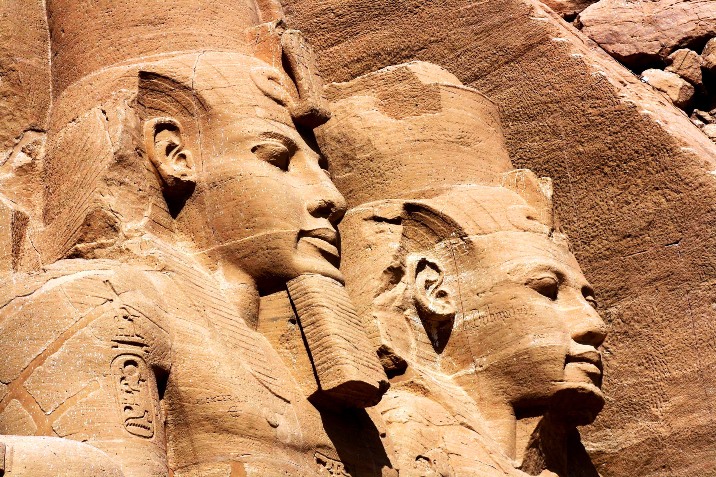
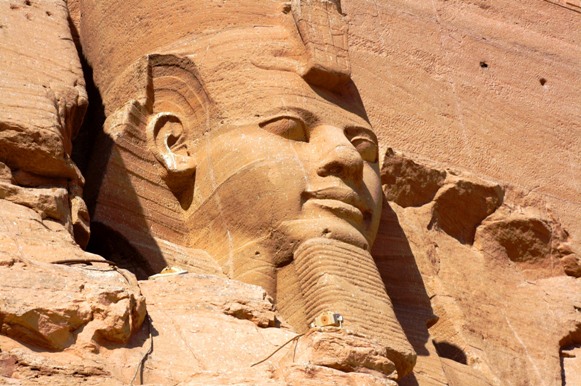
The Rameses Temple has 4 statues of Rameses II over 20 metres high fronting a complex of halls and rooms carved 60 metres into the rockface with hieroglyphics still in excellent condition with the colours of the oiginal paint still easily discernable. Unfortunatley, no photos of the inside are allowed. The complex got buried in sand around the 6th century BC and not re-discoverd until the early 1800s - probably why it's in such good nick.
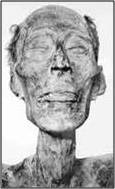
|
Ramesses or Rameses or Ramses. Rameses (II, The Great), one of the 11 pharoahs with that name, is now on display in the Egyptian Museum at Cairo where you can stare his 3,200 year old unwrapped mummy right in the face through a glass case where the old geezer doesn't look quite as imposing any more. |
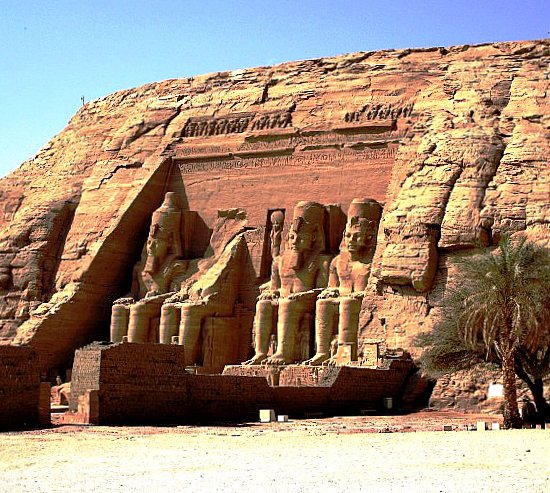
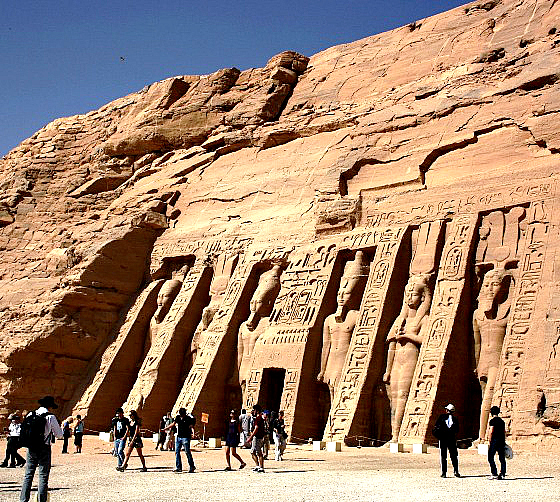
Nefertari, not to be confused with Nefertiti, was one of the great royal wives of Rameses II. The temple (right) is about 100 metres from the Ramses Temple (left). Its statues, slightly more than ten meters high, are of the king and queen. On either side of the portal are two statues of the king, wearing the white crown of Upper Egypt (south colossus) and the double crown (north colossus); flanked by statues of the queen and the king, and the only time in Egyptian art where the statues of the king and his consort are equal in size.
Sinai
Bucket List Rating 
Sinai, a focus for religion and for conflict, as inseparable as ever, from before Moses to the 6 Day War and still a bit risky - our driver telling us he'd run any unofficial road blocks. Didn't see any though!
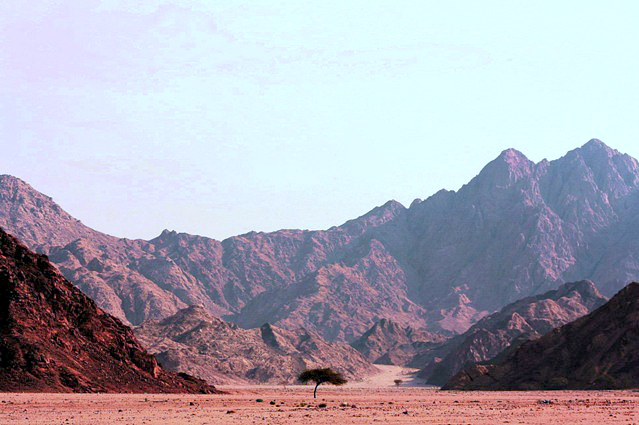
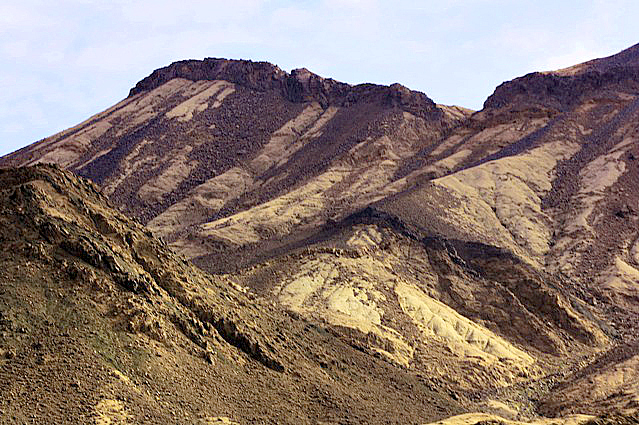
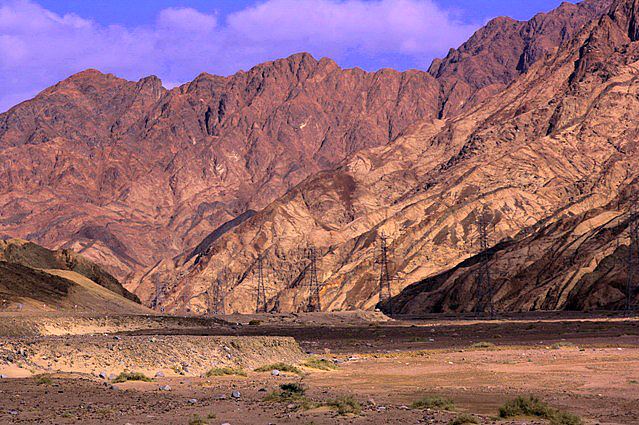
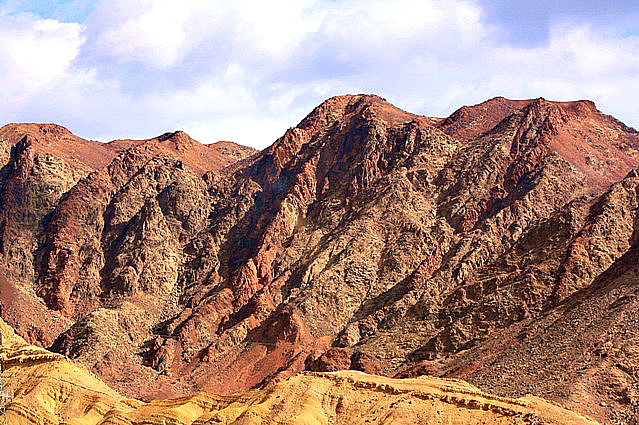
Sinai mountains on the drive from Sharm El-Sheikh to Nuweiba. Good quality road and spectacular mountain and desert scenery that provided an enjoyable interlude beween the disappointments of the start and finishing points. Didn't see much of Sharm El-Sheikh at the start but it seemed too resorty, and saw too much of Nuweiba at the end, which seemed too shitty.
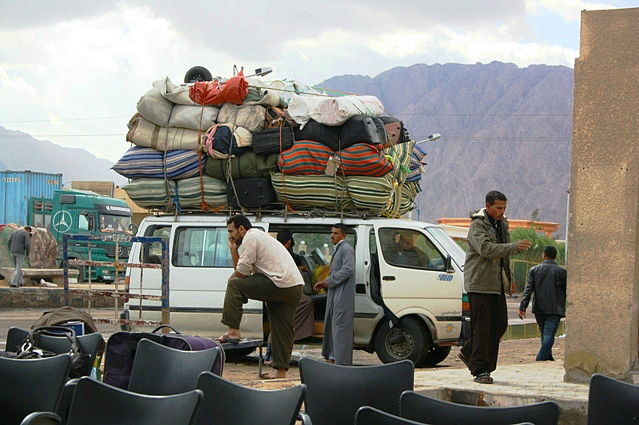
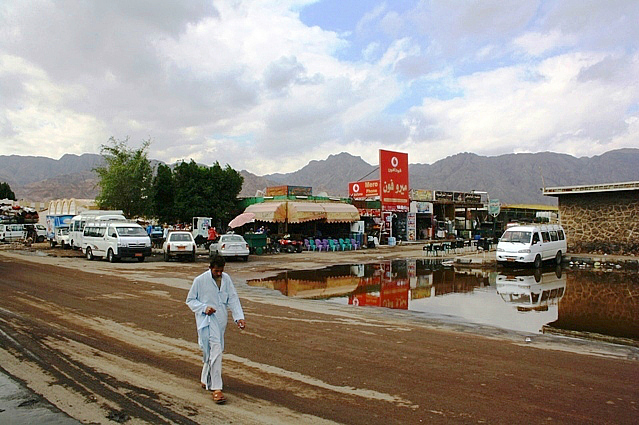
Nuweiba. This was the best spot we could find to spend the hours until the ferry to Jordan was ready. The best spot.
A loud and angry tirade from the speakers at a nearby mosque added to the already bleak atmosphere. Somewhere in Nuweiba is an imam who really needs a chill pill. Seriously, how do people derive any sort of comfort or gratification from such nasty, beligerent harangues? It may have been in Arabic but the tone was unmistakeable.
The vibe of the place was giving us the creeps so after a couple of teas at the cafe we decided to decamp early to the ferry terminal and its big, sparse departure hall with facilities that could be politely described as crude. We spent a couple of boring hours as the obvious objects of curiosity from the locals. Being constantly stared at gets a tad disconcerting - every movement followed by dozens of pairs of eyes.
Passing through Egyptian customs was a laissez faire process - we needed to go looking for the customs office to get our passports processed. A couple of young backbackers hadn't given it any thought and were not allowed to board the ferry without having to walk some distance back for processing. Luckily for them the ferry ran on Egyptian time and they were able to make it. An enforced overnight stay in Nuweiba would not be my idea of fun.
Travel notes:
- Luxor - Karnak and Abu Simbel should not be missed. An astonishing look back in time into ancient Egypt.
- The Great Pyramid's status as a Wonder Of The Ancient World is fully justified. It and the Pyramid of Khafre are truly awe inspiring.
- The Egyptian pyramids are not the only pyramids along the Nile. You didn't know that did you? There's a group of nearly 200 pyramids in Sudan, 200kms north of Khatoum built about 800 years after the end of the Egyptian pyramid era. Smaller narrower and steeper than their Egyptian equivalents but who's ever heard of them? The forgotten pyramids of Meroe; how come stuff like this gets a mention hardly anywhere? '
- Egyptian civilisation is past tense. A tad harsh perhaps, but a glimpse into ancient Egypt justifies any visit while modern Egypt not so much - unless you want to appreciate how good we have it in Oz. Let's face it, experiencing such places is a big reason to travel and I'd encourage anyone that hasn't been there to go with no hesitations.
- Egyptians have mastered the "Exit Through The Gift Shop" model of retail. Leaving the Egyptian Museum, Valley of the Kings, Abu Simbel and the Temple of Hatshepsut are exercises in avoiding attempts to get hold of your money. The style varies from the reasonably civilised at the Egyptian Museum to the desperate, don't-take-no-for-an-answer antics at the Valley of the Kings.
- The personalised cartouche. A cartouche is an hieroglyphic representation of a royal name carved inside an oval shape. Any Egyptian jeweller can find the necessary hieroglyphs to inscribe your name as a cartouche onto the trinkets he wants to flog you. Ancient Egyptians named Bruce or Rita! Who knew?
- Metal detectors are everywhere - hotels, museums, the Pyramids. Not many worked, but if one beeped an alert the security guards tended to ignore it. Perhaps we looked totally non-threatening.
- Public crappers. To be avoided if at all possible, the users' aiming skills are astonishingly poor. Keep your sphyncter puckered for the duration. Those hole-in-the-floor bogs are disgusting. Us old blokes with less than optimal bladder pressure need to stand close to hit a target. Bugger the standing close - we'd aim from about 3 feet away and end up pissing on the floor; which usually improved the standard of hygene of the place.
- Small brown bumps and bruises on the foreheads of most older Egyptian men. A result of more than 40 years of connecting with mosque floors 5 times a day would be my guess.
- A shopkeeper in the Street Of The Tentmakers (Sharia Khayamiya) in old Islamic Cairo, on hearing my accent, rushed into his shop to retrieve a copy of the Sydney Morning Herald to show me where some of his craftwork got a mention in an article on a Melbourne craft exhibition.
- Hulks of planes along the runway on landing in Cairo. Not crashed planes, they looked as if they been cannibalised for parts and then left to gather dust.
- Calls to prayer over tinny loudspeakers from a mosque near our Giza hotel - the Go-kart Races we came to call it; sounding for all the world like a pack of racing 2-stroke engines.
- The Sinai falls within the great arid climatic belt crossing northern Africa and southwestern Asia. The climate in winter has a relatively high amount of precipitation (125 mm) and occasional torrential rains. The pilot on our flight from Cairo must've had a heads-up from the meteorologists - the flight crew was indulging in a few cigarettes in the cockpit, possibly to calm their nerves because we hit one hell of a storm upon descent into Sharm El Sheik that bounced the plane all over the sky and resulted in an initial aborted landing, Sean's fingernails were embedded into his arm-rests and the terminal, roads and hotel were all flooded.
- Should you leave a country on a high note or on a low note? At Nuweiba you have the low note option imposed upon you. Publicised as a tourism highlight of resorts and fabulous scuba diving on coral reefs, our experience was one of a shit-hole, literally and figuratively. Gloomy, grimy, unwelcoming and inefficient.
- This young Aussie bloke didn't like Egypt - Travel in Egypt, go fuck yourself. We had hints of similar experiences, but not this bad. We were glad we went, good and bad.
